
New In 2024, Comprehensive Guide for Free Video Translator Downloading

A Comprehensive Guide for Free Video Translator Downloading
Welcome to our comprehensive guide on video translator download, your gateway to a diverse world of multimedia content. In an era where connecting with a global audience is paramount, the ability to break language barriers through video translation is a game-changer. Whether you’re a content creator, language enthusiast, this guide will walk you through the essential factors to consider, step-by-step instructions for a seamless video translator download, and address common questions related to translating English to Hindi videos.
Part 1: Step-by-step Instructions for Video Translator Downloading

Now that we’ve explored the crucial factors to consider when venturing into video translation let’s embark on a practical journey — downloading a video translator. Follow these step-by-step instructions to integrate this powerful tool into your content creation toolkit seamlessly. Additionally, we’ll recommend two reputable video translator apps to guide you through the installation process.
A Versatile Video Translator Tool: Virbo
As a multilingual tool, Virbo takes real-time translation to the next level. Accessible online and through dedicated applications, Virbo boasts advanced features that enhance communication dynamics. Its capabilities extend to video language translation, making it a valuable addition to the subtitle translation toolkit.
Step 1: Visit the official Virbo website or use the dedicated software/app.
Generate Voice Online Download APP Now Free Download
Step 2: Upload your desired file for instant translation.

Step 3: Choose the target language for translation. Virbo’s extensive language support allows you to cater to a broad audience.

Step 4: Click the “Translate” button, triggering the initiation of the translation process.
Translating English to Hindi Made Easy: Descript
Descript is a revolutionary platform that redefines the landscape of audio and video editing. Pioneering the concept of text-based editing, it allows users to edit multimedia content as easily as editing a document. With its intuitive interface, users can manipulate audio and video files by simply editing the transcribed text, seamlessly making changes to the corresponding media.
Step 1: Navigate to the official Descript Translator website, the digital haven where linguistic precision meets innovation.

Step 2: Upload your video file directly onto the platform, initiating the process of transforming spoken words into the language of your choice.

Step 3: Customize your translation experience by choosing your desired language.

Step 4: Once the translation is complete, download the translated text or share it directly from the platform.
Part 2: Important Factors to Consider While Translating Videos
In the vibrant landscape of digital content, the ability to transcend linguistic boundaries is a crucial aspect of reaching a diverse audience. When venturing into the realm of video translation, it’s essential to consider various factors to ensure an accurate and meaningful representation of your content. Let’s delve into the key considerations that can significantly impact the quality of your video translations.
1. Content Accuracy
In the intricate dance of video translation, accuracy takes center stage. When selecting a video translation tool, it’s imperative to prioritize those that not only promise but guarantee precise content translation. The soul of your message lies in its accuracy, and choosing a tool that preserves the essence and nuances of the original message establishes a deep and meaningful connection with your viewers through every frame of the translated content.
2. Language Support
The beauty of global content creation lies in its linguistic diversity. Opt for a video translator that transcends language boundaries—a true polyglot. Choosing a tool with broad language support empowers you to cater to the diverse linguistic preferences of your audience, creating an inclusive and accessible viewing experience. Your selected tool should be a gateway to a world where language is not a barrier but a bridge.
3. Subtitle Customization
Visual elements, especially subtitles, contribute significantly to the overall viewer experience. Seek a video translator that goes beyond the basics, offering options for customizing subtitles. The ability to adjust not only the appearance but also the timing of subtitles ensures that your translated content aligns seamlessly with the rhythm and tone of your original video. This customization transforms your subtitles from a mere translation tool to an integral part of your storytelling.
4. User-Friendly Interface
In the fast-paced and dynamic landscape of content creation, efficiency is the key to success. Choose a video translation tool adorned with a user-friendly interface—a design that is intuitive and serves as a compass guiding both beginners and experienced users effortlessly through the translation process. A tool that feels familiar and accessible contributes not only to a smoother workflow but also to a more enjoyable and productive content creation experience.
5. Offline Functionality
In a world where the ubiquity of the internet is not guaranteed, the ability to navigate offline is a valuable asset. Consider a video translator that offers offline capabilities, allowing you to enjoy translated content even when a stable internet connection is elusive. This feature provides convenience and flexibility, ensuring your content creation journey is not hindered by connectivity constraints.
Break Language Barriers Now with Wondershare Virbo - Video Translator!
Part 3: FAQs Related to Translating English to Hindi Video and Downloading it
As you delve into the realm of video translation, it’s natural to have questions about the process, especially when aiming to translate content from English to Hindi. Let’s address some frequently asked questions to provide clarity and guidance on translating English to Hindi videos and the downloading process.
Q1. Can I Download a Video Translator for Free?
Yes, many video translators like Virbo offer free versions with basic features. It’s advisable to visit the official website of your chosen video translator to obtain accurate information on free and premium offerings.
Q2. Is Offline Translation Possible?
Many video translators offer offline functionality. During the download process, check for features related to offline translation to ensure that the tool supports this capability. Offline functionality allows you to work on translations even without a stable internet connection.
Q3. Can I Customize Subtitles for Translated Videos?
Yes, Virbo video translators allow the customization of subtitles. Explore the settings or preferences within the downloaded tool to adjust the appearance, timing, and other aspects of subtitles.
Q4. Are There Specific Video Formats Supported by the Translator?
So far, Virbo only allows uploading MP4 files. Stay tuned for future updates!
Conclusion
In a nutshell, the dynamic landscape of video translation is a journey marked by precision, creativity, and accessibility. As creators, language enthusiasts, or viewers, our exploration has unveiled a spectrum of considerations crucial for a seamless and enriching experience.
Armed with these insights, venture into the world of video translation with confidence, knowing that every frame carries the power to resonate across borders, fostering a global connection through powerful translation tools like Wondershare Virbo.
Generate Voice Online Download APP Now Free Download
Step 2: Upload your desired file for instant translation.

Step 3: Choose the target language for translation. Virbo’s extensive language support allows you to cater to a broad audience.

Step 4: Click the “Translate” button, triggering the initiation of the translation process.
Translating English to Hindi Made Easy: Descript
Descript is a revolutionary platform that redefines the landscape of audio and video editing. Pioneering the concept of text-based editing, it allows users to edit multimedia content as easily as editing a document. With its intuitive interface, users can manipulate audio and video files by simply editing the transcribed text, seamlessly making changes to the corresponding media.
Step 1: Navigate to the official Descript Translator website, the digital haven where linguistic precision meets innovation.

Step 2: Upload your video file directly onto the platform, initiating the process of transforming spoken words into the language of your choice.

Step 3: Customize your translation experience by choosing your desired language.

Step 4: Once the translation is complete, download the translated text or share it directly from the platform.
Part 2: Important Factors to Consider While Translating Videos
In the vibrant landscape of digital content, the ability to transcend linguistic boundaries is a crucial aspect of reaching a diverse audience. When venturing into the realm of video translation, it’s essential to consider various factors to ensure an accurate and meaningful representation of your content. Let’s delve into the key considerations that can significantly impact the quality of your video translations.
1. Content Accuracy
In the intricate dance of video translation, accuracy takes center stage. When selecting a video translation tool, it’s imperative to prioritize those that not only promise but guarantee precise content translation. The soul of your message lies in its accuracy, and choosing a tool that preserves the essence and nuances of the original message establishes a deep and meaningful connection with your viewers through every frame of the translated content.
2. Language Support
The beauty of global content creation lies in its linguistic diversity. Opt for a video translator that transcends language boundaries—a true polyglot. Choosing a tool with broad language support empowers you to cater to the diverse linguistic preferences of your audience, creating an inclusive and accessible viewing experience. Your selected tool should be a gateway to a world where language is not a barrier but a bridge.
3. Subtitle Customization
Visual elements, especially subtitles, contribute significantly to the overall viewer experience. Seek a video translator that goes beyond the basics, offering options for customizing subtitles. The ability to adjust not only the appearance but also the timing of subtitles ensures that your translated content aligns seamlessly with the rhythm and tone of your original video. This customization transforms your subtitles from a mere translation tool to an integral part of your storytelling.
4. User-Friendly Interface
In the fast-paced and dynamic landscape of content creation, efficiency is the key to success. Choose a video translation tool adorned with a user-friendly interface—a design that is intuitive and serves as a compass guiding both beginners and experienced users effortlessly through the translation process. A tool that feels familiar and accessible contributes not only to a smoother workflow but also to a more enjoyable and productive content creation experience.
5. Offline Functionality
In a world where the ubiquity of the internet is not guaranteed, the ability to navigate offline is a valuable asset. Consider a video translator that offers offline capabilities, allowing you to enjoy translated content even when a stable internet connection is elusive. This feature provides convenience and flexibility, ensuring your content creation journey is not hindered by connectivity constraints.
Break Language Barriers Now with Wondershare Virbo - Video Translator!
Part 3: FAQs Related to Translating English to Hindi Video and Downloading it
As you delve into the realm of video translation, it’s natural to have questions about the process, especially when aiming to translate content from English to Hindi. Let’s address some frequently asked questions to provide clarity and guidance on translating English to Hindi videos and the downloading process.
Q1. Can I Download a Video Translator for Free?
Yes, many video translators like Virbo offer free versions with basic features. It’s advisable to visit the official website of your chosen video translator to obtain accurate information on free and premium offerings.
Q2. Is Offline Translation Possible?
Many video translators offer offline functionality. During the download process, check for features related to offline translation to ensure that the tool supports this capability. Offline functionality allows you to work on translations even without a stable internet connection.
Q3. Can I Customize Subtitles for Translated Videos?
Yes, Virbo video translators allow the customization of subtitles. Explore the settings or preferences within the downloaded tool to adjust the appearance, timing, and other aspects of subtitles.
Q4. Are There Specific Video Formats Supported by the Translator?
So far, Virbo only allows uploading MP4 files. Stay tuned for future updates!
Conclusion
In a nutshell, the dynamic landscape of video translation is a journey marked by precision, creativity, and accessibility. As creators, language enthusiasts, or viewers, our exploration has unveiled a spectrum of considerations crucial for a seamless and enriching experience.
Armed with these insights, venture into the world of video translation with confidence, knowing that every frame carries the power to resonate across borders, fostering a global connection through powerful translation tools like Wondershare Virbo.
Generate Voice Online Download APP Now Free Download
Translate Videos Like a Pro with Subtitle Cat: Your Essential Guide
When it comes to video content creation, you need to consider your audience. At a time when reaching a global audience is a major concern, having multilingual subtitles is a necessity. Tools like Subtitles Cat allow you to translate your videos to subtitles that appeal to different audiences. With accurate subtitles, you will be able to increase user engagement and viewership. The Subtitle Cat translate allows you to quickly and accurately generate subtitles in different languages. In this article, we will provide an overview of Subtitle Cat Com and how to use the tool in your video projects.
Part 1. Overview of Subtitle Cat as a Video Translating Tool
Subtitle Cat is an online video translation tool. The powerful tool is designed to simplify the process of adding subtitles to videos. With the use of Cat Translator Google capabilities, the online tool works to generate translated subtitles in seconds. Users can streamline the process of translating subtitles to reach a wider audience. This helps in bridging the language barrier and making video content more accessible.

Compatibility
- Online tool
Key Features
- Automatic Speech Recognition (ASR): Automatically generates subtitles from spoken voice in videos using an advanced ASR technology. By automating the process, subtitle Cat translates videos easily without the need for manual transcription.
- Multi-lingual Capabilities: Subtitle Cat is designed to translate subtitles for films in various languages. With a base of over 100 languages, the Cat takes subtitles files in their original language (.srt) for quick conversions to any other language.
- User-Friendly Interface: An intuitive user interface that allows you to easily edit and customize subtitles. Subtle Cat offers accurate results with higher readability for your audience. You also get the option to split or merge lines and adjust font styles to your liking.
- Machine Translation (MT): Automatic generation of subtitles into various languages using the highly integrated MT engine. This allows Subtitle Cat to facilitate multilingual communication across different types of videos.
Pros
- An easy-to-use online platform for quick video subtitle translation
- An efficient tool that saves time and cost that would have been spent on manual transcription and translation
- Highly accurate subtitle translations using advanced ASR and MT technologies
- A user-friendly and intuitive interface for quick subtitle editing
- A highly flexible tool that supports different types of videos and subtitle formats
Cons
- Machine translation is sometimes limited and may produce unnatural-sounding results that require human editing
- The customization options offered by Subtitle Cat are limited
Part 2. Step-by-Step Guide: Translating Videos with Subtitle Cat
Using Subtitle Cat to translate videos is completely free. You can start with a video file like a movie, find the subtitles, and translate it to the desired language. Known as the cat that translates subtitles, the platform is designed to offer users a seamless translation experience. No technical expertise is needed as you only upload your subtitles and the Cat does the translation for you. Here is a step-by-step guide to follow:
Step 1Visit Subtitle Cat
The first step is to visit the Subtitle Cat website and search for the movie you are interested in translating. Type in the name of the video and click search. Sometimes, you may not find what you are looking for. Just head onto the internet with your favorite search engine, and search for the subtitle file of the video or film you are interested in. Download the .srt file your file and then upload it to Subtitle Cat.

Step 2Explore the Substiles Index
Subtitle Cat offers a list of subtitles that you can with. Browse through the latest subtitles or the results of your search from Step 1 and click on the desired one. If you uploaded the .srt file in the previous step, it will automatically appear in the search result ready to be translated.

Step 3Select a Language for Translation
From the list of available language subtitles, click on the one that you are interested in and translate. This will prompt Subtitle Cat to translate the subtitles into that language.

Step 4Download Translated Subtitles
The Cat subtitle translate is often quick and takes only a few seconds for the tools to generate subtitles in the requested language. Once the translation process is complete, download your new subtitle file for your video. The file contains the subtitles for your video file. However, you will need the .srt file, the video file, and a video player to view it. Add the .srt vile to your video player (VLC, Movie and TV app in Widows, or video player in Mac). This will display the new subtitles when you play the video.

Part 3. Best Alternative with Subtitle Cat: Wondershare Virbo
When it comes to translating the subtitles of your video, you want a tool that is easy to use and effective. One of the best alternatives to Subtitle Cat is Wondershare Virbo . This video translation tool offers similar functionalities to Subtitle Cat but with a better experience and results. Here is a quick comparison between the two alternatives.
Translate Video Online Free Download
1. All-rounded Analysis on Wondershare Virbo and Subtitle Cat
01 Compatibility
Wondershare Virbo is compatible with Windows, and phone devices while Subtitle Cat is an online tool
02 Key Features
In addition to ASR and MT, Virbo also offers advanced subtitle editing features. Users can manage time codes, adjust font styles, translate specific segments of their subtitles, and use collaborative tools such as project sharing and real-time editing.
03 Wider Format Use
Virbo supports a wider range of video and subtitle formats, allowing users to cater to a broad spectrum of audiences.
04 Instantly View Subtitles
Virbo translates and adds subtitles to your video on the same platform. You do not have to download the .srt file and then upload it again in a different software. Everything is done on the Virbo software, and the exported file is ready for viewing.
Comparing the two subtitle translation tools indicates that one is superior to the other. While Subtitle Cat boats of a user-friendly interface and affordability, Virbo stands out with a comprehensive feature set. Users can work with a wider range of video formats and collaborate with others on projects. Based on the above comparison, it is evident that Wondershare Virbo is better than Subtitle Cat.
2. Unlock Smooth Video Translating Experience with Wondershare Virbo
Using Wondershare Virbo to translate subtitles is quite easy. The software comes with AI-powered capabilities to automatically translate subtitles, saving you the time and effort you would have spent in manual transcription and translation. Simply upload your video, and select the language you want to translate your subtitles to, and the software will do the rest. To give you a complete picture of how the software works, here is a step-by-step process to follow.
Translate Video Online Free Download
Step 1Download Virbo to Your Device
Start by downloading Virbo to your phone or PC. Virbo is also available online and can be used directly on the website. You can register a new Wondershare account using your email or login with social media.

Step 2Launch AI Video Translator Feature
On the menu section of the Virbo window, locate the “Video Translator” feature and click on it. This will launch the feature, prompting you to take the next step.

Step 3Upload Your Video
Once the Video Translator window pops up, click on “Upload the video” you want to work with. Virbo’s free plan requires uploads to be 30s to 5min long in MP4 or MOV formats, and a file size of up to 200 MB. Select the original language and a target language that you want your new subtitles to be in.
Click “Translate” to start the translation process. Virbo will detect the human spoken language in the video and generate the translated video subtitles.

Step 4Export Video with Translated Subtitles
Virbo will translate the video subtitles to the desired language within a few seconds. The process is automated and no manual tweaking is needed. Click on “Export” to generate the video with new subtitles.

Translate Video Online Free Download
Conclusion
Translating the subtitles of your video is advantageous in many ways. It makes your videos more accessible and useful to your audience. A tool like Subtitle Cat helps to make the translation faster and easier. However, for more accurate results and use across different types of videos, we recommend using WonderShare Virbo. The video translation software comes with AI-powered features that make subtitle translation more efficient and effective.
How To Translate Video From Japanese to English Online?
Let’s say you’re a business owner or a content creator in Japan. If you want to broaden your horizons, you may need to translate videos from Japanese to English. This is because English is spoken globally. You can sell more, share knowledge, and connect with English speakers worldwide.
For streaming platforms, turning Japanese content into English is a ticket to reaching audiences all over the globe. And businesses using Japanese tech might need translated training videos for their remote workers.
Seeing this growing need, it’s clear you need effective video translation solutions. So, we’ve created a guide to help you choose the best method for each step, including using AI. Finding the right way to translate videos is important, so keep reading!

Part I. Completed Process To Translate Videos From Japanese to English
When you want to translate a video from Japanese to English, you can follow some general steps, no matter how you decide to do it. Let’s break down each step for you:
- Step 1: Video Transcription
Before you can translate, you need to understand what’s being said. So, the initial step is to do a video transcription. You can either hire professionals or use a Japanese-to-English video translator app to convert the spoken language to text.
Transcription captures all the Japanese dialogue, ensuring the English translation is spot-on. Having the text file lets you edit it, like shortening sentences or adjusting cultural references. This results in a smoother and more natural English video for you.
- Step 2: Translation
Once you have the transcript, you can translate the Japanese text into English. A good translation ensures the original message is accurately conveyed in the new language. It avoids any misunderstandings or misinterpretations for your English viewers. You have two options to do it. Both have strengths and weaknesses, so let’s see which suits your needs best.
- Professional Human Translation Services
When you want to translate a video from Japanese to English, a pro can make the sentences sound right for your audience. These professionals tweak the tone to be natural and engaging. If you go to translation agencies, they make sure the work is top-notch by going through strict editing and reviewing. However, human translation services cost more and take a bit more time than machine translation tools.
- Machine Translation Tools
Machine translation tools are fast and affordable. They can be a good option for short, simple videos where perfect accuracy isn’t critical. But it often struggles with complex language, cultural references, and humor.
- Step 3: Timing and Implementation
Let’s talk about making the Japanese to English video translation seamless. After translating, you want the words to match the original rhythm and pace of the speaker in the video. It keeps things feeling natural and engaging for you, the viewer. Plus, speakers use non-verbal cues like jokes, emotions, and pauses. Matching the translated text with these visual cues keeps the video’s meaning and impact intact.
How to do it? Professional workflows often use timecode, which gives each video frame a unique timestamp. It ensures super precise subtitle placement for that perfect synchronization. Some video editing tools even have “waveforms” to help visually line up subtitles with the spoken parts.

Here are several ways to add the translated Japanese text to your video:
- Subtitles
Subtitles are like on-screen translators for you. They show the English dialogue while the original Japanese audio goes on. It helps you understand if you get the visuals but not the language. The focus is on getting the main point across and sometimes making the sentences shorter for easier reading.
- Closed Captions
Like subtitles, closed captions (CC) are words shown on the screen. They go beyond spoken words, covering all the sounds you hear, like dialogue, music, and even background noises. The main goal is to help you, especially if you’re deaf or struggle with hearing. So, if you’re aiming for videos everyone can enjoy, try a video translator from Japanese to English with CC capabilities.
- Dubbing
Dubbing is a more intricate process where the original Japanese audio track is completely replaced. Voice actors step in to record the translated script in English. They try to sync up their words with the lip movements of the characters on screen. It makes it seem like the characters speak English right from the start, giving you a more immersive viewing experience.
- Voiceover
In this method, a narrator reads the translated script in English over the original Japanese audio. It’s often used in documentaries or educational videos when you need more info beyond just the dialogue.
- Step 4: Final Review and Approval
Alright, so you’re at the last step now. You’re giving the translated video a good check to ensure everything’s spot-on – accurate, consistent, and top-notch quality. It means looking out for any problems in the translation, timing, or how you choose to do it. Once you give the thumbs up to the final version, you’ve got a smooth and effective English video ready for your audience.
You might find the previous steps tedious and time-consuming. But what if you could translate your video from Japanese to English in minutes? That way, you could reach new markets and expand your influence faster. AI video translators like Wondershare Virbo can help you spread your work, passions, and stories to a global audience. Read on to learn more.
Part II. Virbo: Realistic AI Japanese to English Video Translator
You’re excited about your new product, but your explainer video feels like it’s only speaking to half the world. You know the potential exists, but the language barrier holds you back. Or perhaps you’ve captured stunning footage from your recent trip to Kyoto, but sharing it with your followers feels like a lost cause.
Here’s the deal: you don’t have to stick to a small crowd.

Get Started Online Free Download
Virbo uses the latest AI tech to automatically translate, dub voice, and add synced subtitles to your Japanese video. This app is simple to use and can translate video content into over 20 languages. Virbo translates Japanese to English videos in a few minutes – all free for videos under 2 minutes!
Here’s what makes Virbo stand out:
- Precise Lip-sync: Say goodbye to awkward, out-of-sync translations. Virbo AI video translator ensures the translated dialogue seamlessly matches the speaker’s lip movements and facial expressions, creating a natural and engaging experience (still in beta, but getting better every day!).
- AI Cloning Voices: Add engagement with Virbo’s AI-cloned voices that capture the essence of human speech. Choose from a range of natural-sounding voices that express the right emotions and add personality to your content.
- Soundtrack Reserved: Don’t lose the original soundtrack that sets the mood. Virbo allows you to keep it intact, enhancing its impact even in different languages.
- Versatile Compatibility: Virbo works across various platforms, including Windows, iOS, and Android. You can even use it online for ultimate flexibility.
- Affordable Excellence: Experience the power of AI video translation without breaking the bank. Virbo offers high-quality solutions at affordable prices, making them accessible to everyone.
Part III. How To Translate Japanese to English Video Using Virbo Automatically
Using Virbo AI video translator can help you be more productive. Here’s how to translate a video in Japanese to English online for free:
- Step 1: Go to Virbo AI video translator online from your browser for quick access. You can also download the app for your desktop. Once you’ve chosen your access point, sign in using your existing Google, Facebook, email, Apple, or Twitter account.
Get Started Online Free Download
- Step 2: Choose and upload your Japanese video file from your local storage. Ensure the video is between 10 seconds to 5 minutes long and in MP4 or MOV format, up to 500 MB for optimal processing.
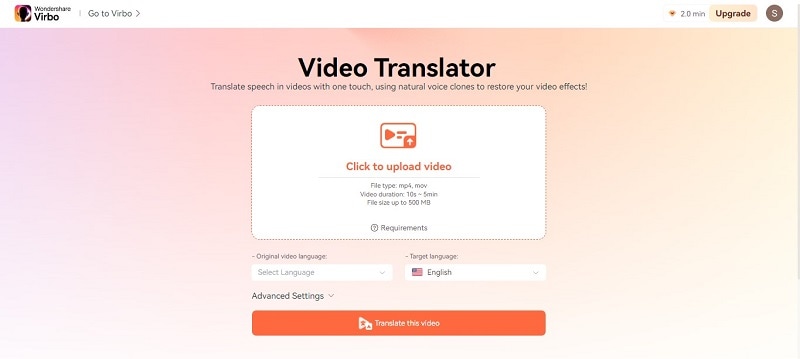
- Step 3: Specify Japanese as the Original video language and English as the desired Target language.
- Step 4: Virbo offers Advanced Settings to customize the translated view result. Toggle on the Lip-sync, Subtitle, and Proofread video script switches to enable them when needed.
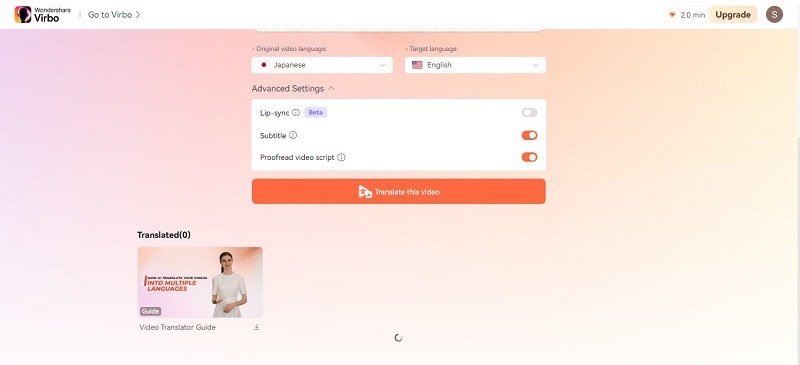
- Step 5: Click Translate this video to start the translation process once everything is set.
- Step 6: Wait a few moments while Virbo performs video transcription. Review the text and edit if needed.
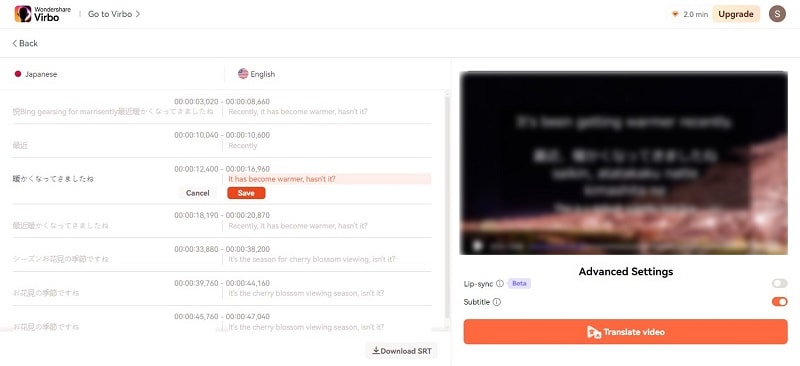
- Step 7: Click Translate video to proceed, then the video will go to the queue.
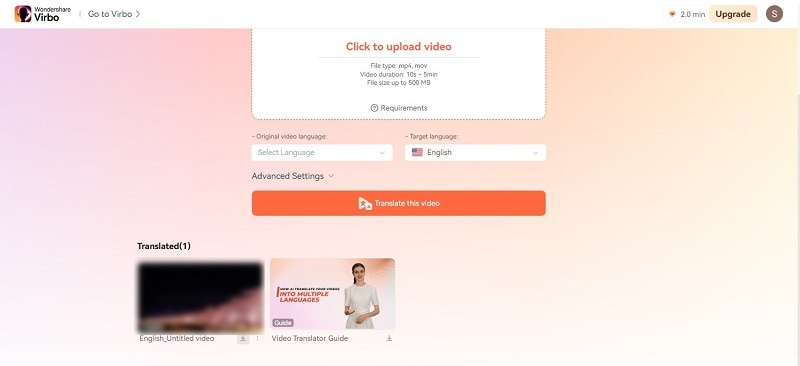
- Step 8: After completion, you can preview the translated video before downloading the final English version.
Part IV. How To Achieve the Best Video Translation Results?
You can’t always translate a video from Japanese to English without a few difficulties. Here are some ways to make the process easier for you:
Divide the Script Into Manageable Chunks
Break down the script into smaller sections like sentences, phrases, or even shorter segments depending on the video’s pace and complexity. It allows for more precise timing adjustments later.
Use a “Shadowing” Technique
As you watch the video, read the translated text out loud. Adjust the subtitle timing to match how you naturally speak. Doing this makes the flow feel more natural for you and the viewers.
Test and Refine
Now that you’ve set the timing for the subtitles, it’s time to put them to the test with your target audience. This step is important because it helps you catch any timing problems, awkward phrasing, or cultural differences that might have slipped through during editing.
Listen to what your audience says, and then use that feedback to tweak the subtitles. Your goal is to make sure they’re clear, short, and match the audience’s culture.
AI for Pre-Translation Tasks
Take advantage of AI tools for speech-to-text conversion and automatic subtitle generation. It can save time, but always proofread for accuracy and natural flow.
File Compatibility
Ensure your chosen translation service or tool supports the format of your video file. The common formats include MP4, MOV, and AVI.
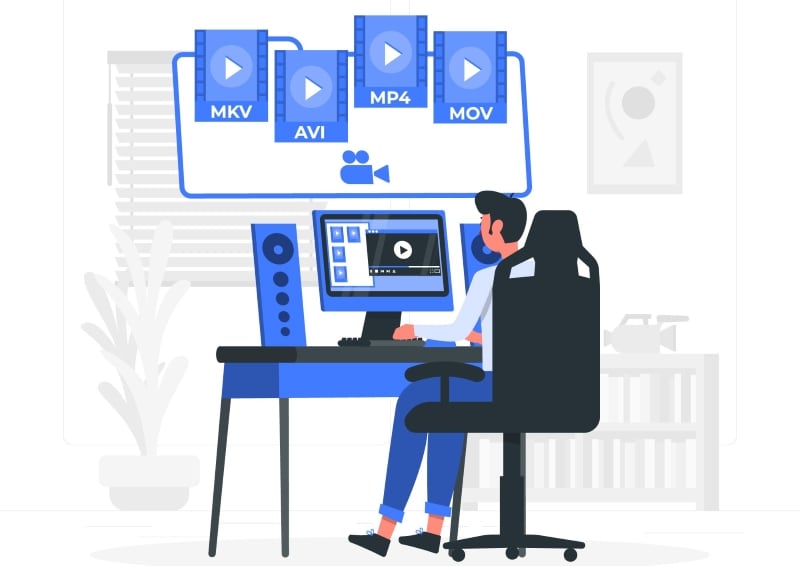
Conclusion
So you’ve seen how easy it can be to translate a video from Japanese to English. It’s up to you whether you will ask for the help of human translators, video editors, or AI video translators.
As you know, Virbo goes beyond being a basic Japanese to English video translator and converter. It takes the complexity out of translation, offering seamless and accurate results.
But remember, even the best AI translation can benefit from a human touch. Don’t be afraid to experiment and refine your translated video for the best outcome. With a little effort, you can bridge the language barrier and share your Japanese video content with the world.
Let’s say you’re a business owner or a content creator in Japan. If you want to broaden your horizons, you may need to translate videos from Japanese to English. This is because English is spoken globally. You can sell more, share knowledge, and connect with English speakers worldwide.
For streaming platforms, turning Japanese content into English is a ticket to reaching audiences all over the globe. And businesses using Japanese tech might need translated training videos for their remote workers.
Seeing this growing need, it’s clear you need effective video translation solutions. So, we’ve created a guide to help you choose the best method for each step, including using AI. Finding the right way to translate videos is important, so keep reading!

Part I. Completed Process To Translate Videos From Japanese to English
When you want to translate a video from Japanese to English, you can follow some general steps, no matter how you decide to do it. Let’s break down each step for you:
- Step 1: Video Transcription
Before you can translate, you need to understand what’s being said. So, the initial step is to do a video transcription. You can either hire professionals or use a Japanese-to-English video translator app to convert the spoken language to text.
Transcription captures all the Japanese dialogue, ensuring the English translation is spot-on. Having the text file lets you edit it, like shortening sentences or adjusting cultural references. This results in a smoother and more natural English video for you.
- Step 2: Translation
Once you have the transcript, you can translate the Japanese text into English. A good translation ensures the original message is accurately conveyed in the new language. It avoids any misunderstandings or misinterpretations for your English viewers. You have two options to do it. Both have strengths and weaknesses, so let’s see which suits your needs best.
- Professional Human Translation Services
When you want to translate a video from Japanese to English, a pro can make the sentences sound right for your audience. These professionals tweak the tone to be natural and engaging. If you go to translation agencies, they make sure the work is top-notch by going through strict editing and reviewing. However, human translation services cost more and take a bit more time than machine translation tools.
- Machine Translation Tools
Machine translation tools are fast and affordable. They can be a good option for short, simple videos where perfect accuracy isn’t critical. But it often struggles with complex language, cultural references, and humor.
- Step 3: Timing and Implementation
Let’s talk about making the Japanese to English video translation seamless. After translating, you want the words to match the original rhythm and pace of the speaker in the video. It keeps things feeling natural and engaging for you, the viewer. Plus, speakers use non-verbal cues like jokes, emotions, and pauses. Matching the translated text with these visual cues keeps the video’s meaning and impact intact.
How to do it? Professional workflows often use timecode, which gives each video frame a unique timestamp. It ensures super precise subtitle placement for that perfect synchronization. Some video editing tools even have “waveforms” to help visually line up subtitles with the spoken parts.

Here are several ways to add the translated Japanese text to your video:
- Subtitles
Subtitles are like on-screen translators for you. They show the English dialogue while the original Japanese audio goes on. It helps you understand if you get the visuals but not the language. The focus is on getting the main point across and sometimes making the sentences shorter for easier reading.
- Closed Captions
Like subtitles, closed captions (CC) are words shown on the screen. They go beyond spoken words, covering all the sounds you hear, like dialogue, music, and even background noises. The main goal is to help you, especially if you’re deaf or struggle with hearing. So, if you’re aiming for videos everyone can enjoy, try a video translator from Japanese to English with CC capabilities.
- Dubbing
Dubbing is a more intricate process where the original Japanese audio track is completely replaced. Voice actors step in to record the translated script in English. They try to sync up their words with the lip movements of the characters on screen. It makes it seem like the characters speak English right from the start, giving you a more immersive viewing experience.
- Voiceover
In this method, a narrator reads the translated script in English over the original Japanese audio. It’s often used in documentaries or educational videos when you need more info beyond just the dialogue.
- Step 4: Final Review and Approval
Alright, so you’re at the last step now. You’re giving the translated video a good check to ensure everything’s spot-on – accurate, consistent, and top-notch quality. It means looking out for any problems in the translation, timing, or how you choose to do it. Once you give the thumbs up to the final version, you’ve got a smooth and effective English video ready for your audience.
You might find the previous steps tedious and time-consuming. But what if you could translate your video from Japanese to English in minutes? That way, you could reach new markets and expand your influence faster. AI video translators like Wondershare Virbo can help you spread your work, passions, and stories to a global audience. Read on to learn more.
Part II. Virbo: Realistic AI Japanese to English Video Translator
You’re excited about your new product, but your explainer video feels like it’s only speaking to half the world. You know the potential exists, but the language barrier holds you back. Or perhaps you’ve captured stunning footage from your recent trip to Kyoto, but sharing it with your followers feels like a lost cause.
Here’s the deal: you don’t have to stick to a small crowd.

Get Started Online Free Download
Virbo uses the latest AI tech to automatically translate, dub voice, and add synced subtitles to your Japanese video. This app is simple to use and can translate video content into over 20 languages. Virbo translates Japanese to English videos in a few minutes – all free for videos under 2 minutes!
Here’s what makes Virbo stand out:
- Precise Lip-sync: Say goodbye to awkward, out-of-sync translations. Virbo AI video translator ensures the translated dialogue seamlessly matches the speaker’s lip movements and facial expressions, creating a natural and engaging experience (still in beta, but getting better every day!).
- AI Cloning Voices: Add engagement with Virbo’s AI-cloned voices that capture the essence of human speech. Choose from a range of natural-sounding voices that express the right emotions and add personality to your content.
- Soundtrack Reserved: Don’t lose the original soundtrack that sets the mood. Virbo allows you to keep it intact, enhancing its impact even in different languages.
- Versatile Compatibility: Virbo works across various platforms, including Windows, iOS, and Android. You can even use it online for ultimate flexibility.
- Affordable Excellence: Experience the power of AI video translation without breaking the bank. Virbo offers high-quality solutions at affordable prices, making them accessible to everyone.
Part III. How To Translate Japanese to English Video Using Virbo Automatically
Using Virbo AI video translator can help you be more productive. Here’s how to translate a video in Japanese to English online for free:
- Step 1: Go to Virbo AI video translator online from your browser for quick access. You can also download the app for your desktop. Once you’ve chosen your access point, sign in using your existing Google, Facebook, email, Apple, or Twitter account.
Get Started Online Free Download
- Step 2: Choose and upload your Japanese video file from your local storage. Ensure the video is between 10 seconds to 5 minutes long and in MP4 or MOV format, up to 500 MB for optimal processing.

- Step 3: Specify Japanese as the Original video language and English as the desired Target language.
- Step 4: Virbo offers Advanced Settings to customize the translated view result. Toggle on the Lip-sync, Subtitle, and Proofread video script switches to enable them when needed.

- Step 5: Click Translate this video to start the translation process once everything is set.
- Step 6: Wait a few moments while Virbo performs video transcription. Review the text and edit if needed.

- Step 7: Click Translate video to proceed, then the video will go to the queue.

- Step 8: After completion, you can preview the translated video before downloading the final English version.
Part IV. How To Achieve the Best Video Translation Results?
You can’t always translate a video from Japanese to English without a few difficulties. Here are some ways to make the process easier for you:
Divide the Script Into Manageable Chunks
Break down the script into smaller sections like sentences, phrases, or even shorter segments depending on the video’s pace and complexity. It allows for more precise timing adjustments later.
Use a “Shadowing” Technique
As you watch the video, read the translated text out loud. Adjust the subtitle timing to match how you naturally speak. Doing this makes the flow feel more natural for you and the viewers.
Test and Refine
Now that you’ve set the timing for the subtitles, it’s time to put them to the test with your target audience. This step is important because it helps you catch any timing problems, awkward phrasing, or cultural differences that might have slipped through during editing.
Listen to what your audience says, and then use that feedback to tweak the subtitles. Your goal is to make sure they’re clear, short, and match the audience’s culture.
AI for Pre-Translation Tasks
Take advantage of AI tools for speech-to-text conversion and automatic subtitle generation. It can save time, but always proofread for accuracy and natural flow.
File Compatibility
Ensure your chosen translation service or tool supports the format of your video file. The common formats include MP4, MOV, and AVI.

Conclusion
So you’ve seen how easy it can be to translate a video from Japanese to English. It’s up to you whether you will ask for the help of human translators, video editors, or AI video translators.
As you know, Virbo goes beyond being a basic Japanese to English video translator and converter. It takes the complexity out of translation, offering seamless and accurate results.
But remember, even the best AI translation can benefit from a human touch. Don’t be afraid to experiment and refine your translated video for the best outcome. With a little effort, you can bridge the language barrier and share your Japanese video content with the world.
How to Make Lip Sync Video Without Installing Any App
TikTok has transformed the social media landscape through its short-form video content. They encourage users to make creative content using popular audio clips. Which enables them to entertain, gain recognition, and contribute to the platform.
Lip-syncing is a big part of what makes TikTok popular. Many users post lip-syncing videos that imitate voices from songs, movies, or trending audio clips. This art of lip-syncing has become an essential element of TikTok’s culture. Now, you might wonder **how to lip-sync on TikTok videos. This article will teach us how to make it effortlessly.
Part 1. Why Do People Lip Sync on TikTok?
Lip-syncing involves mimicking the words or vocals of an existing audio track. TikTok users take this concept to new heights by lip-syncing popular songs or clips. Lip-sync is appealing because it lets people get creative and reach a large audience.
Here are a few reasons why people engage in **lip sync TikTok:
- Self-expression: Lip-sync allows users to embody their favorite artists or characters by showcasing their personality and creativity.
- Entertainment: Many users lip-sync to entertain followers. They offer comedic performances, heartfelt renditions, or engaging storytelling.
- Virality: TikTok’s algorithm favors engaging content and well-executed lip-sync videos. They have the potential to go viral, rapidly gaining likes, shares, and followers.
Part 2. How to Make Lip Sync Video on TikTok
Here’s the step-by-step guide on how to lip sync on TikTok and captive your followers:
- Step 1. Open the TikTok app and tap the “+” button.
Start with opening the TikTok app on your phone. Then, tap the “+” button at the bottom of your screen to make a new video.
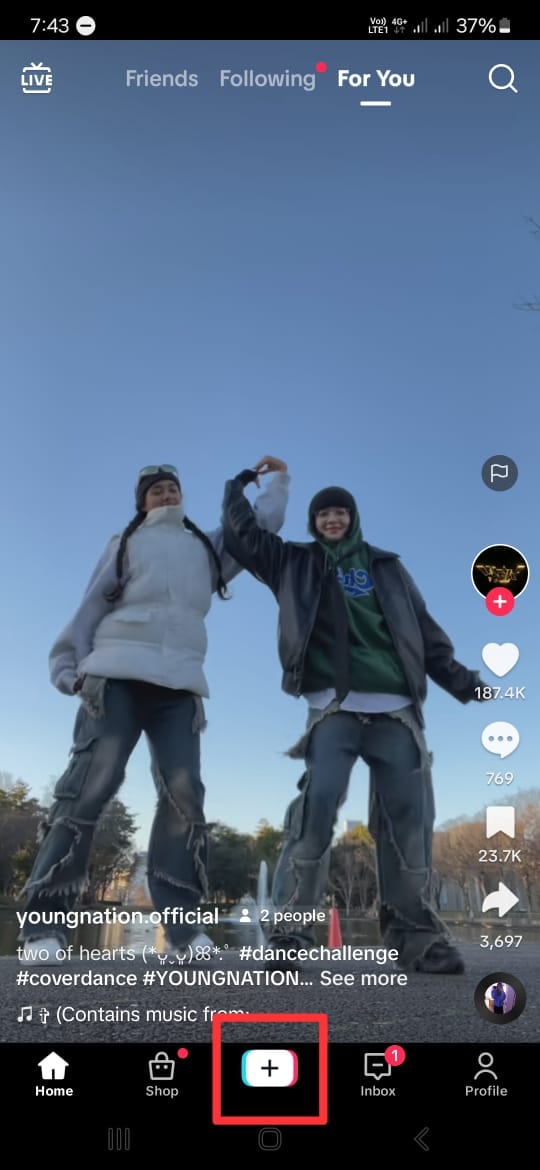
- Step 2. Add a song that you want to lip-sync to.
Next, click “Add Sound” with the musical note icon at the top of the screen. If you have a specific song in mind, you can find it by searching it on the search tab. Then, tap the song and click the check icon beside it.
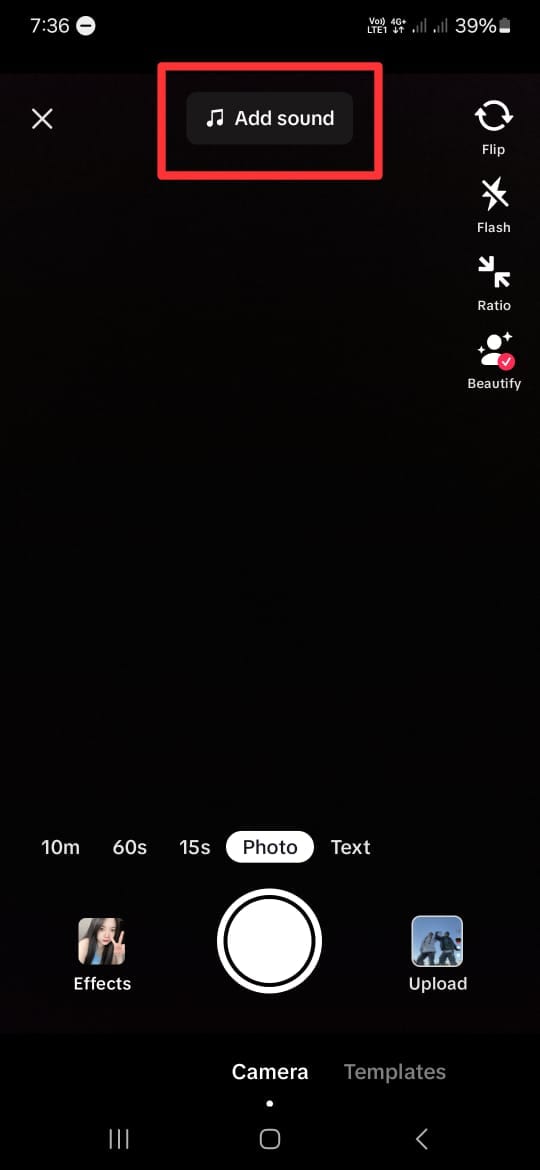
- Step 3. Choose the duration and the part of the song.
After choosing the song you want, you will return to the recording screen. Here, select your video duration at the bottom of the screen. You can choose between 10 minutes, 60 seconds, and 15 seconds. Remember that the duration of the songs on TikTok is usually only 30 to 60 seconds.
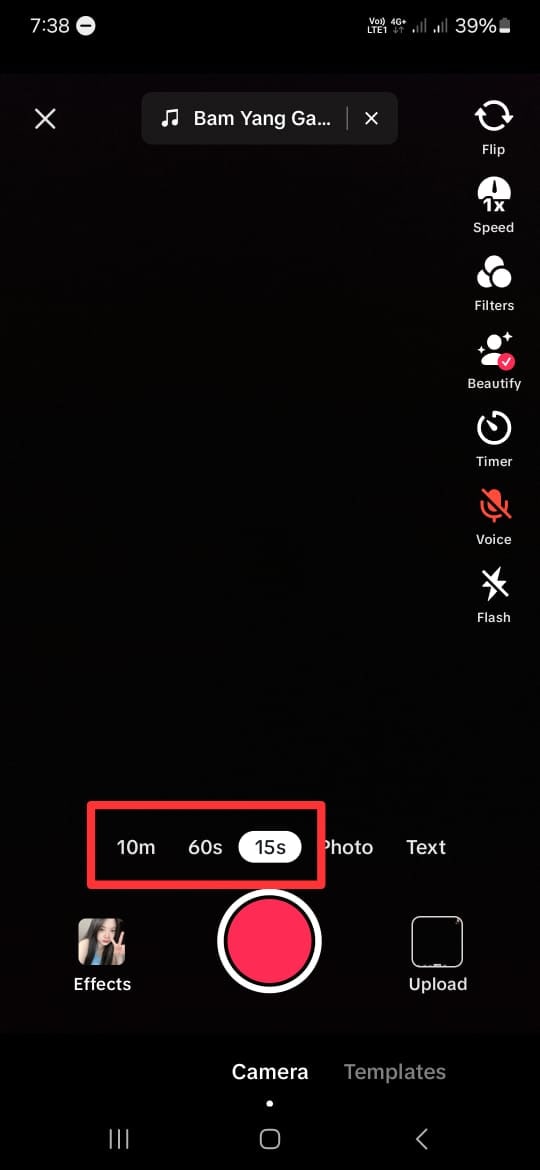
- Step 4. Choose the part of the song.
TikTok allows you to change the part of the song when lip-sync. However, the duration of the video should be less than the duration of the chosen song.
To do this, click on the song’s name at the top of your screen. Then, the bottom of your screen will display your chosen song. Tap the scissor icon and slide the playback to change the part of the song. Click “Done” once you have finished editing.
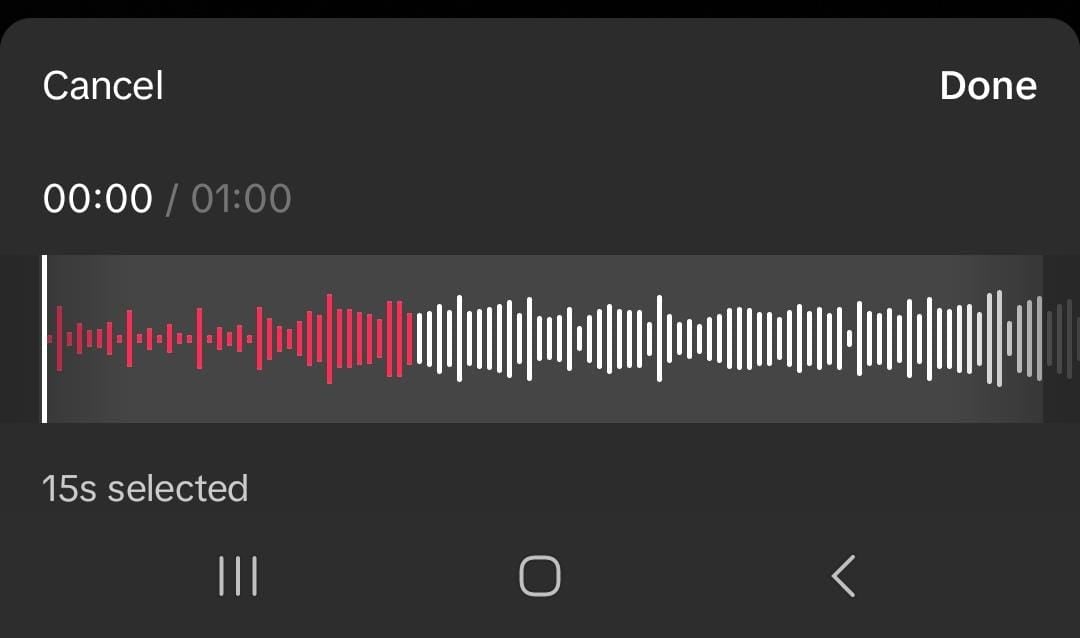
- Step 5. Tap on the red button.
If you are ready to record, tap the red button at the bottom of your screen. Then TikTok will play the chosen part of the song and record your lip-sync simultaneously. You can pause and continue the recording by clicking the same red button.
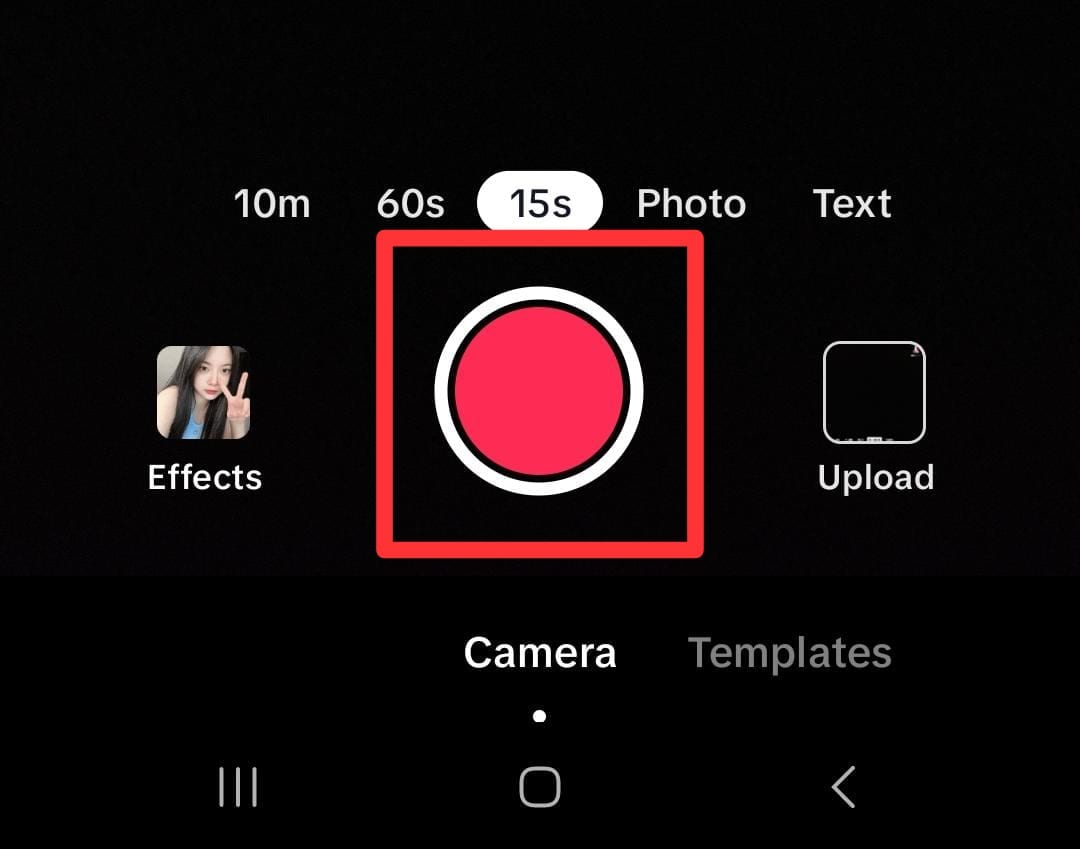
- Step 6. Post the video.
If you are satisfied with the results of your edits, click Next to proceed to the posting stage. Here, you can write a description and any other information you want. Click Post to share your lip-sync video to TikTok.

Creating a video on TikTok by lip-syncing is a fun and creative way to express yourself and connect with others. By following the steps above, you can create a lip-sync video on the TikTok app with ease. Keep in mind that by using these steps, you need to memorize the sentences and understand the beat of the chosen songs.
Part 3. How to Make Lip Sync Video Without Memorizing the Words
Making a **TikTok lip-sync video can be challenging because you must remember and match the words with the music. But there are three simple methods to make it easier.
Method 1: Record at slower speed
You can slow the speed down while recording instead of trying to keep up with the song. This technique lets you hear, understand, and follow the words more easily.
Here’s how to slow down the recording:
- Step 1. Follow steps 1 to 4 from the step-by-step guide in Part 2.
Start by following the first to fourth steps from the guide in Part 2 above.
- Step 2. Set the speed record slower.
On the recording screen, click on the Speed icon on the right side of the screen. To make it slower, choose 2x or 3x. This step will make your recording time 2 or 3 times longer than it should be.
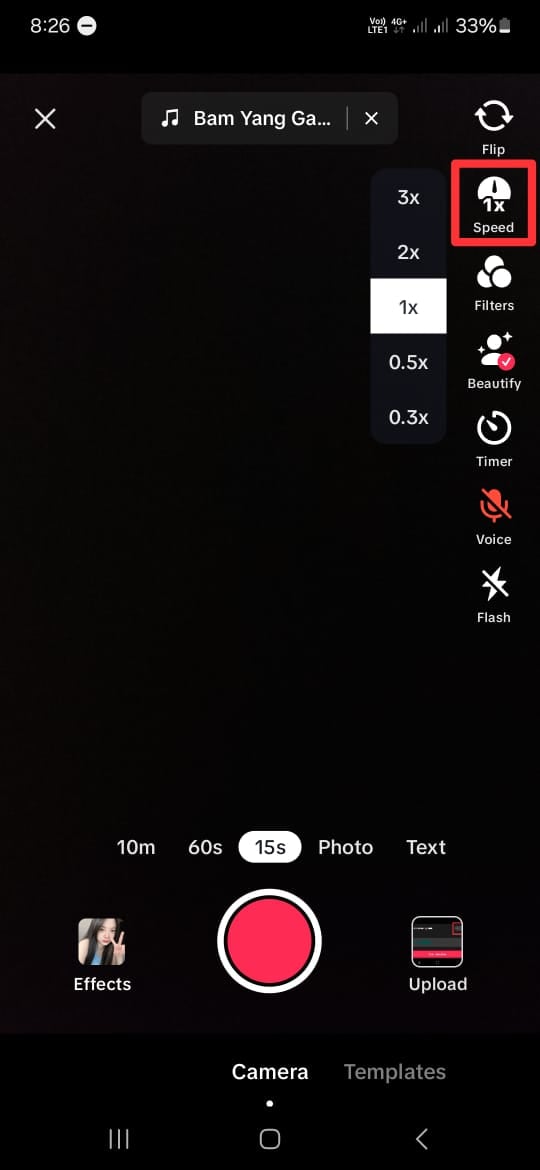
- Step 3. Tap on the red button.
Once you tap the red button, TikTok will play the song slower and record your lip-sync simultaneously. Repeat this step to help you memorize the lyrics and the beat of the songs.
Once you’re comfortable, switch back to normal speed for the final recording. This method will save time and improve accuracy.
Method 2: Purposely delay mouthing the words
While lip-syncing videos may vary in style and pacing, this technique can prove particularly useful for slower rhythms. Moreover, mastering the art of mouth sync on TikTok can elevate the overall production value of lip-syncing videos.
Using the timer feature will give you a slight lag between lip movements and audio playback. Then, it lets creators ensure more precise synchronization during editing. Here’s how to lip-sync on TikTok more easily:
- Step 1. Follow steps 1 to step 4 from the step-by-step guide in Part 2.
Like Method 1, you can start by following the first to fourth steps from the guide in Part 2 above.
- Step 2. Delay the recording
On the recording screen, click on the Timer icon on the right side of the screen. Here, you can set the timer to 3 to 10 seconds to delay the recording’s start. You can also drag and set the recording limit if you want.
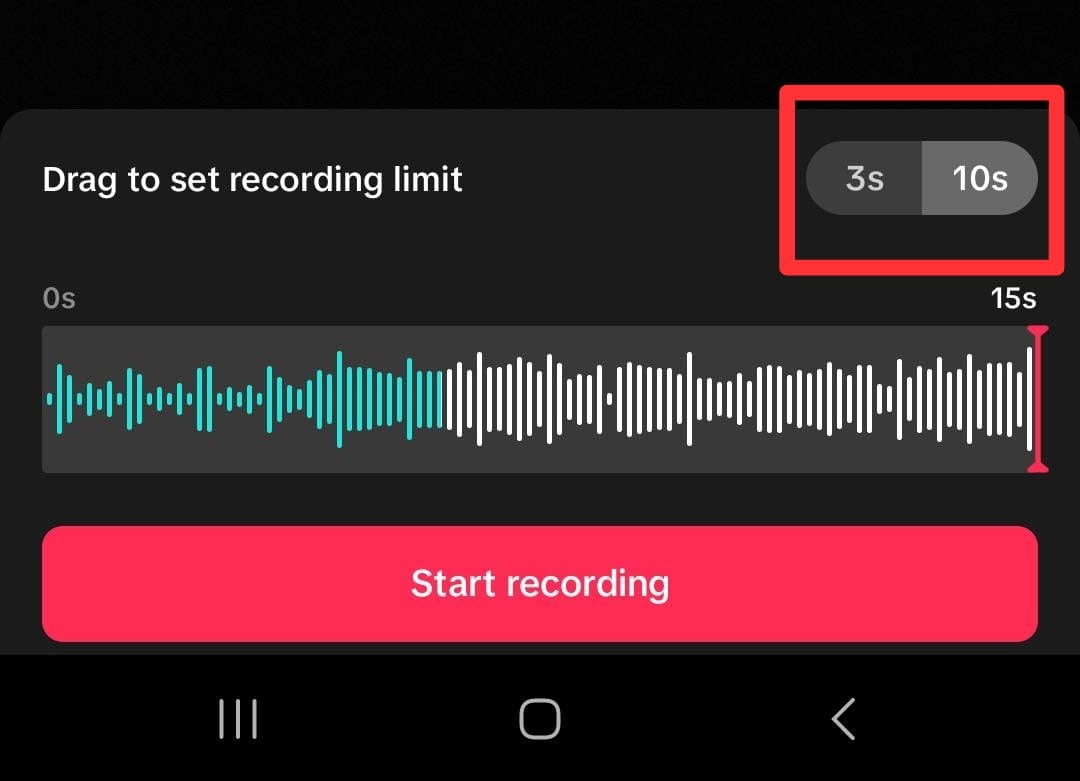
- Step 3. Start the recording
Then click “Start recording” to record the video with the timer on.
Method 3: Use a Photo Talking Tool
Next, consider using a Talking Photo feature by Wondershare Virbo. This method is for you who want to create engaging TikTok lip-sync videos without memorizing the words.
Virbo’s Talking Photo feature tool lets you upload a portrait of your photo and then make it appear as though it is speaking along with the audio. You do not have to install the app because you can use this feature online on their official website.
Here’s how to use Wondershare Virbo - Photo Talking feature to create a TikTok lip-sync video:
- Step 1. Start a new project.
Open the Wondershare Virbo website and tap the talking photo function to start a new project.
Get Started Online Free Download
- Step 2. Upload a portrait.
Tap “Upload Photo”, then upload a picture you want to use by following the instructions.
- Step 3. Edit and export.
Insert the text and adjust the voice settings. If you want to insert your own audio, you can use Wondershare Virbo for mobile or Desktop to upload or record your audio. Then, tap “Generate Video” to export.
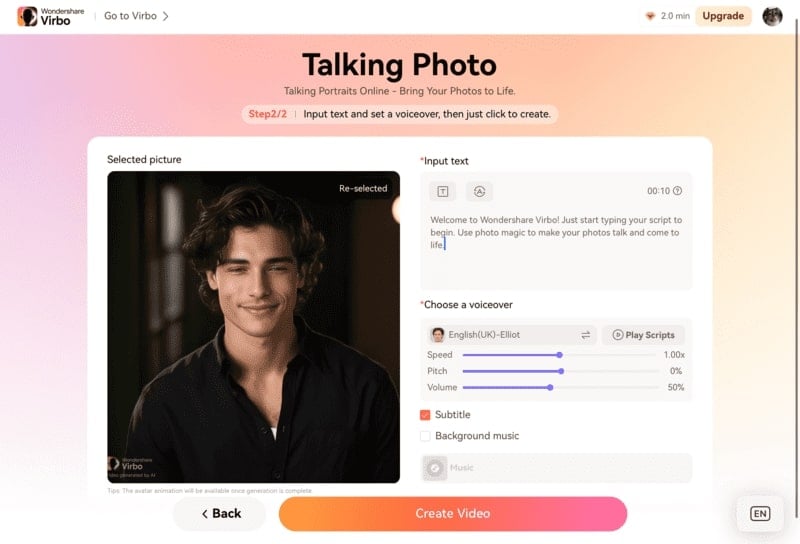
Now, you have successfully made your own TikTok lip-sync video. You can upload it to TikTok and share it with your followers. For more detailed instructions, you can see how to use Virbo’s Photo Talking tool .
Part 4: How To Lipsync Your Video to Any Language Using AI Video Translator
In today’s globalized world, reaching audiences in different languages is important for effective communication. Thanks to technological advancements, there is a tool that can help you translate video content.
Wondershare Virbo – Video Translator offers seamless solutions to translate video content into various languages with AI. Virbo ensures high-quality translations that maintain the integrity and impact of your original message.
How to lipsync TikTok videos to any language with Wondershare Virbo - Video Translator:
- Step 1. Go to Virbo’s official website , then click Generate AI Video Online.
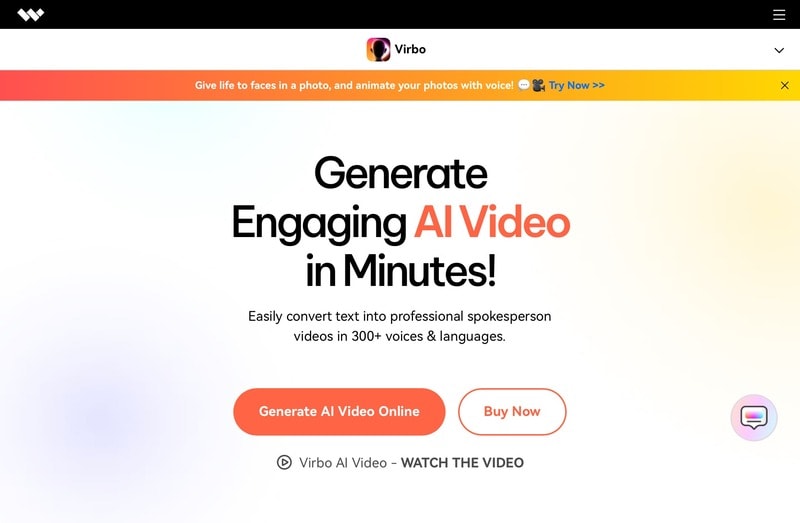
Get Started Online Free Download
- Step 2. Log in or create an account.
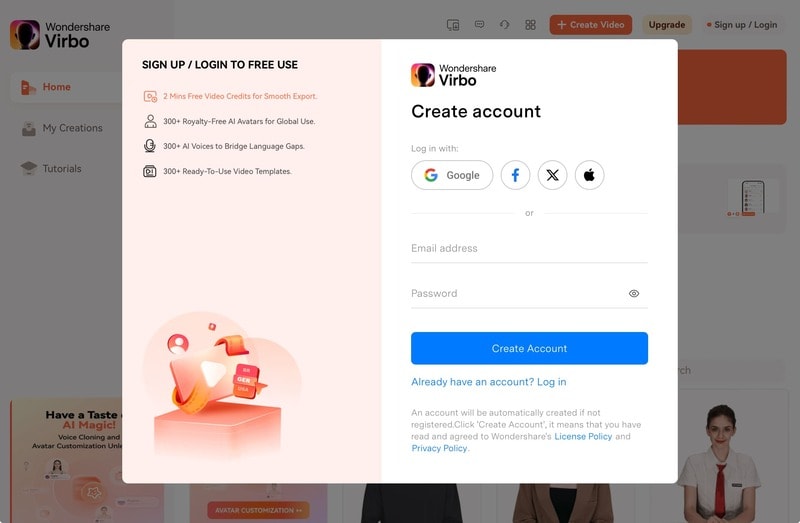
- Step 3. Then, navigate to the Video Translator tool on the Virbo’s homepage.
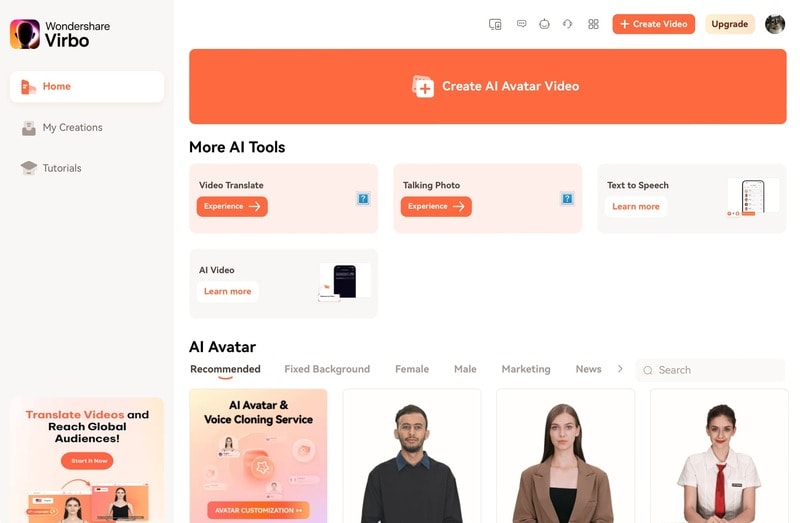
- Step 4. Upload the video.
Once inside the Video Translator interface, upload the video file you wish to translate. Select the original video language and the preferred target language from the available options. Additionally, enable the Lip Sync feature to ensure that the translated audio aligns perfectly with the lip movements in the video.
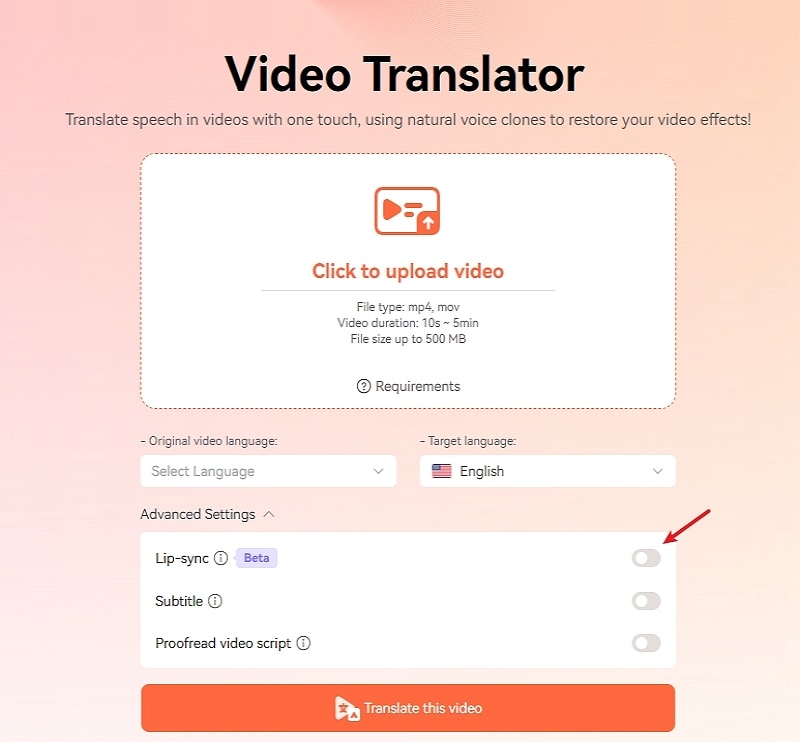
- Step 5. Click “Translate this video” to start translating the video.
Virbo’s Video Translator will use its advanced algorithms to translate the audio and synchronize it with the video seamlessly. Depending on the length and complexity of the video, the translation process may take some time.
Conclusion
Lip-syncing on TikTok has become a significant aspect of TikTok culture. It helps users show their creativity, entertain people, and maybe even become famous. Making **mouth sync TikTok videos usually means remembering lines and matching them to music, but there’s an easier way with Wondershare Virbo’s Talking Photo tool. This tool allows you to upload a portrait and sync it with audio without remembering the lines.
Also, Wondershare Virbo has a Video Translator tool that allows you to translate videos seamlessly into any language. This translator tool helps you communicate with people worldwide and maintain the original message.
TikTok has transformed the social media landscape through its short-form video content. They encourage users to make creative content using popular audio clips. Which enables them to entertain, gain recognition, and contribute to the platform.
Lip-syncing is a big part of what makes TikTok popular. Many users post lip-syncing videos that imitate voices from songs, movies, or trending audio clips. This art of lip-syncing has become an essential element of TikTok’s culture. Now, you might wonder **how to lip-sync on TikTok videos. This article will teach us how to make it effortlessly.
Part 1. Why Do People Lip Sync on TikTok?
Lip-syncing involves mimicking the words or vocals of an existing audio track. TikTok users take this concept to new heights by lip-syncing popular songs or clips. Lip-sync is appealing because it lets people get creative and reach a large audience.
Here are a few reasons why people engage in **lip sync TikTok:
- Self-expression: Lip-sync allows users to embody their favorite artists or characters by showcasing their personality and creativity.
- Entertainment: Many users lip-sync to entertain followers. They offer comedic performances, heartfelt renditions, or engaging storytelling.
- Virality: TikTok’s algorithm favors engaging content and well-executed lip-sync videos. They have the potential to go viral, rapidly gaining likes, shares, and followers.
Part 2. How to Make Lip Sync Video on TikTok
Here’s the step-by-step guide on how to lip sync on TikTok and captive your followers:
- Step 1. Open the TikTok app and tap the “+” button.
Start with opening the TikTok app on your phone. Then, tap the “+” button at the bottom of your screen to make a new video.

- Step 2. Add a song that you want to lip-sync to.
Next, click “Add Sound” with the musical note icon at the top of the screen. If you have a specific song in mind, you can find it by searching it on the search tab. Then, tap the song and click the check icon beside it.

- Step 3. Choose the duration and the part of the song.
After choosing the song you want, you will return to the recording screen. Here, select your video duration at the bottom of the screen. You can choose between 10 minutes, 60 seconds, and 15 seconds. Remember that the duration of the songs on TikTok is usually only 30 to 60 seconds.

- Step 4. Choose the part of the song.
TikTok allows you to change the part of the song when lip-sync. However, the duration of the video should be less than the duration of the chosen song.
To do this, click on the song’s name at the top of your screen. Then, the bottom of your screen will display your chosen song. Tap the scissor icon and slide the playback to change the part of the song. Click “Done” once you have finished editing.

- Step 5. Tap on the red button.
If you are ready to record, tap the red button at the bottom of your screen. Then TikTok will play the chosen part of the song and record your lip-sync simultaneously. You can pause and continue the recording by clicking the same red button.

- Step 6. Post the video.
If you are satisfied with the results of your edits, click Next to proceed to the posting stage. Here, you can write a description and any other information you want. Click Post to share your lip-sync video to TikTok.

Creating a video on TikTok by lip-syncing is a fun and creative way to express yourself and connect with others. By following the steps above, you can create a lip-sync video on the TikTok app with ease. Keep in mind that by using these steps, you need to memorize the sentences and understand the beat of the chosen songs.
Part 3. How to Make Lip Sync Video Without Memorizing the Words
Making a **TikTok lip-sync video can be challenging because you must remember and match the words with the music. But there are three simple methods to make it easier.
Method 1: Record at slower speed
You can slow the speed down while recording instead of trying to keep up with the song. This technique lets you hear, understand, and follow the words more easily.
Here’s how to slow down the recording:
- Step 1. Follow steps 1 to 4 from the step-by-step guide in Part 2.
Start by following the first to fourth steps from the guide in Part 2 above.
- Step 2. Set the speed record slower.
On the recording screen, click on the Speed icon on the right side of the screen. To make it slower, choose 2x or 3x. This step will make your recording time 2 or 3 times longer than it should be.

- Step 3. Tap on the red button.
Once you tap the red button, TikTok will play the song slower and record your lip-sync simultaneously. Repeat this step to help you memorize the lyrics and the beat of the songs.
Once you’re comfortable, switch back to normal speed for the final recording. This method will save time and improve accuracy.
Method 2: Purposely delay mouthing the words
While lip-syncing videos may vary in style and pacing, this technique can prove particularly useful for slower rhythms. Moreover, mastering the art of mouth sync on TikTok can elevate the overall production value of lip-syncing videos.
Using the timer feature will give you a slight lag between lip movements and audio playback. Then, it lets creators ensure more precise synchronization during editing. Here’s how to lip-sync on TikTok more easily:
- Step 1. Follow steps 1 to step 4 from the step-by-step guide in Part 2.
Like Method 1, you can start by following the first to fourth steps from the guide in Part 2 above.
- Step 2. Delay the recording
On the recording screen, click on the Timer icon on the right side of the screen. Here, you can set the timer to 3 to 10 seconds to delay the recording’s start. You can also drag and set the recording limit if you want.

- Step 3. Start the recording
Then click “Start recording” to record the video with the timer on.
Method 3: Use a Photo Talking Tool
Next, consider using a Talking Photo feature by Wondershare Virbo. This method is for you who want to create engaging TikTok lip-sync videos without memorizing the words.
Virbo’s Talking Photo feature tool lets you upload a portrait of your photo and then make it appear as though it is speaking along with the audio. You do not have to install the app because you can use this feature online on their official website.
Here’s how to use Wondershare Virbo - Photo Talking feature to create a TikTok lip-sync video:
- Step 1. Start a new project.
Open the Wondershare Virbo website and tap the talking photo function to start a new project.
Get Started Online Free Download
- Step 2. Upload a portrait.
Tap “Upload Photo”, then upload a picture you want to use by following the instructions.
- Step 3. Edit and export.
Insert the text and adjust the voice settings. If you want to insert your own audio, you can use Wondershare Virbo for mobile or Desktop to upload or record your audio. Then, tap “Generate Video” to export.

Now, you have successfully made your own TikTok lip-sync video. You can upload it to TikTok and share it with your followers. For more detailed instructions, you can see how to use Virbo’s Photo Talking tool .
Part 4: How To Lipsync Your Video to Any Language Using AI Video Translator
In today’s globalized world, reaching audiences in different languages is important for effective communication. Thanks to technological advancements, there is a tool that can help you translate video content.
Wondershare Virbo – Video Translator offers seamless solutions to translate video content into various languages with AI. Virbo ensures high-quality translations that maintain the integrity and impact of your original message.
How to lipsync TikTok videos to any language with Wondershare Virbo - Video Translator:
- Step 1. Go to Virbo’s official website , then click Generate AI Video Online.

Get Started Online Free Download
- Step 2. Log in or create an account.

- Step 3. Then, navigate to the Video Translator tool on the Virbo’s homepage.

- Step 4. Upload the video.
Once inside the Video Translator interface, upload the video file you wish to translate. Select the original video language and the preferred target language from the available options. Additionally, enable the Lip Sync feature to ensure that the translated audio aligns perfectly with the lip movements in the video.

- Step 5. Click “Translate this video” to start translating the video.
Virbo’s Video Translator will use its advanced algorithms to translate the audio and synchronize it with the video seamlessly. Depending on the length and complexity of the video, the translation process may take some time.
Conclusion
Lip-syncing on TikTok has become a significant aspect of TikTok culture. It helps users show their creativity, entertain people, and maybe even become famous. Making **mouth sync TikTok videos usually means remembering lines and matching them to music, but there’s an easier way with Wondershare Virbo’s Talking Photo tool. This tool allows you to upload a portrait and sync it with audio without remembering the lines.
Also, Wondershare Virbo has a Video Translator tool that allows you to translate videos seamlessly into any language. This translator tool helps you communicate with people worldwide and maintain the original message.
How To Auto Translate YouTube Videos Into Different Languages
Are you looking for how to auto translate YouTube videos? Or are you frustrated with auto translate for YouTube feature? We know, that sometimes it works, sometimes it does not. There are limitations, and depending on your use case, you might be frustrated. Learn how to auto translate YouTube video into your language at the click of a button including the ability to auto translate YouTube video captions and subtitles. Using a third-party auto translate captions YouTube software, you can easily translate videos into a language of your choice and add matching auto translated subtitles.
Part 1: How To Translate YouTube Videos Automatically
If you don’t know YouTube recently launched the auto-translate feature for all videos, you can follow the steps below to translate YouTube video into any language:
Step 1
Go to any YouTube video that you would like to translate.
Step 2
Turn on Closed Captions by clicking on the CC button at the bottom.
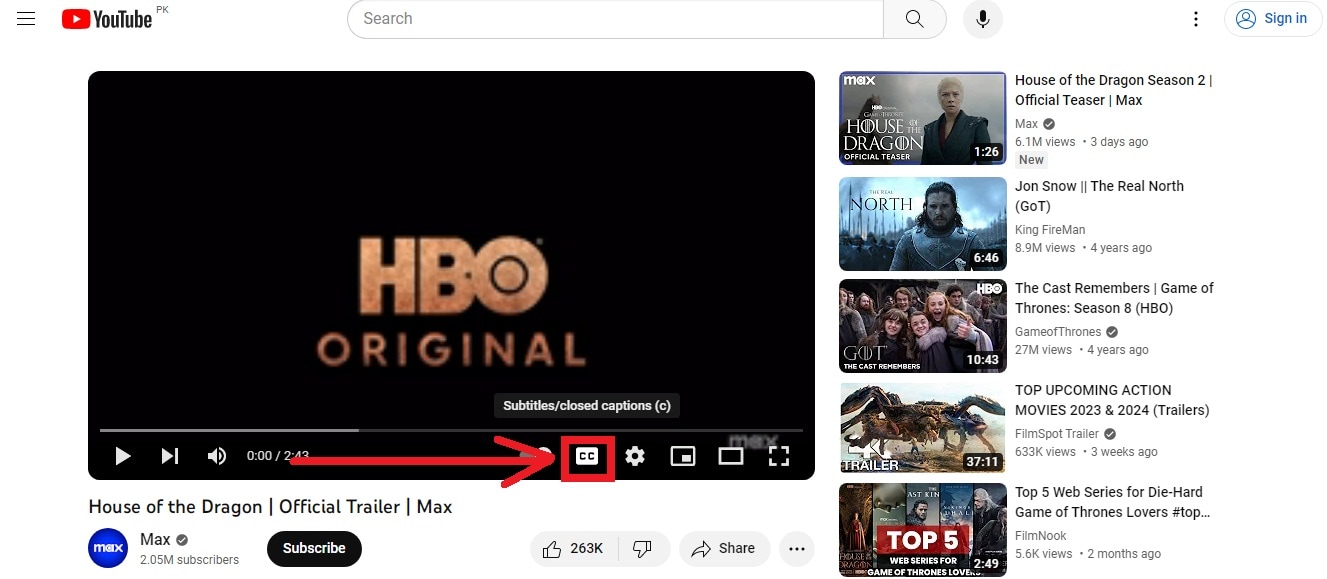
Step 3
Can you see the auto-generated closed captions in English? Good!
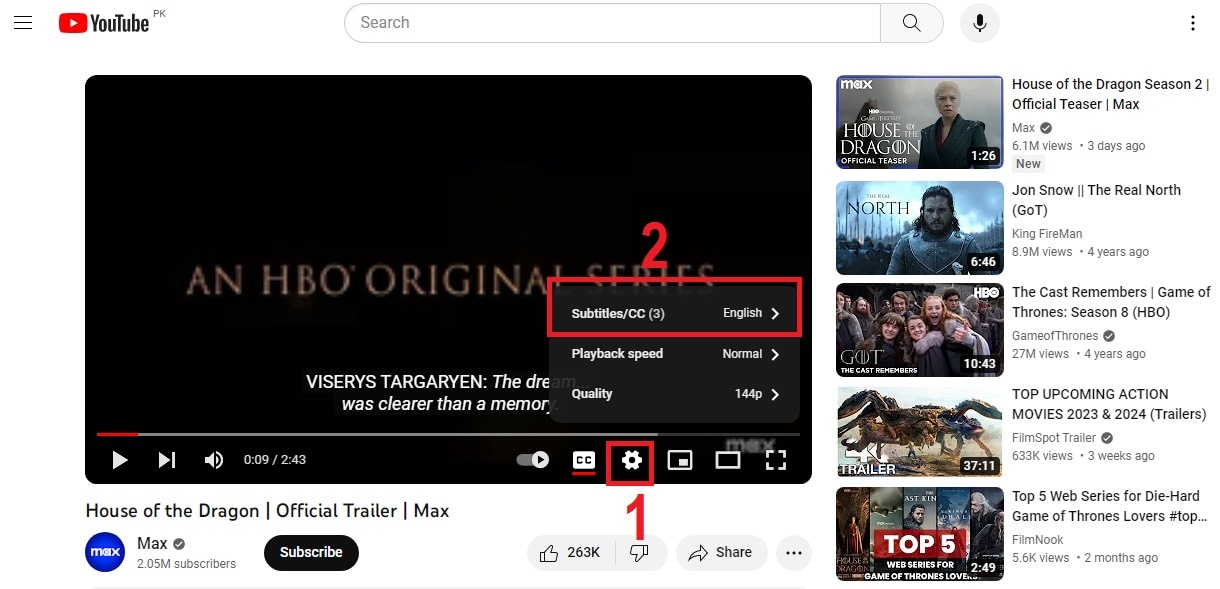
Go to Settings by clicking on the gear icon (as seen above) and click Subtitles/CC.
This will show you all the languages a video is already available in.
Step 4
Go to Auto Translate and select a language.
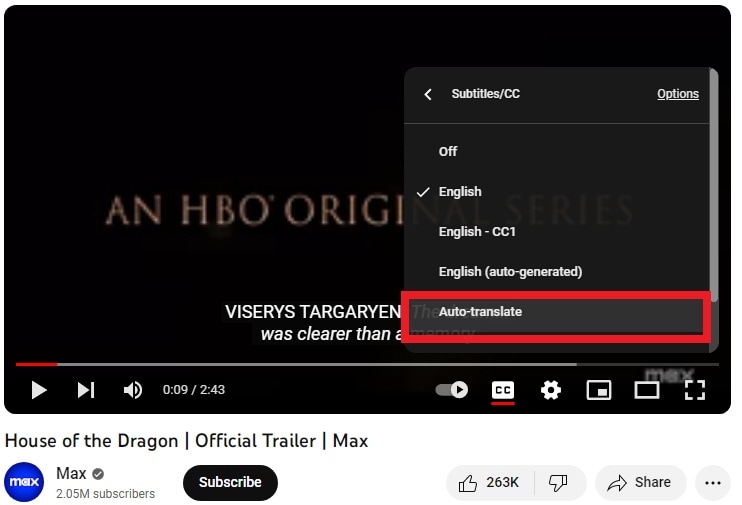
Step 5
For this example, we are selecting Hindi.
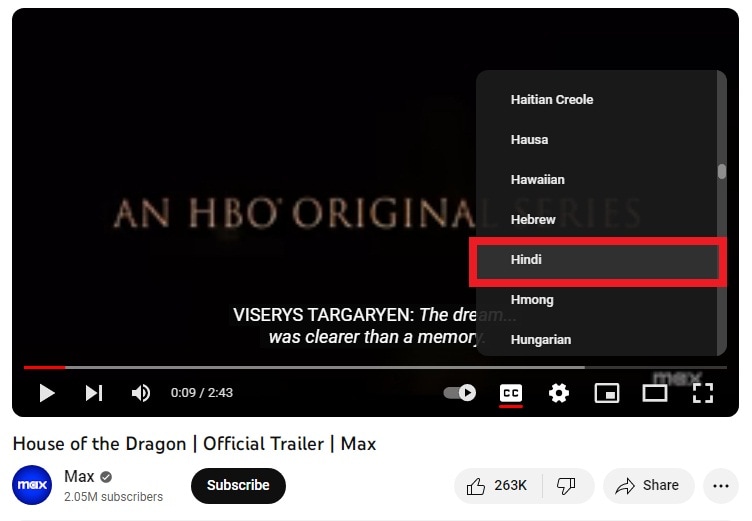
Step 6
As you can see in the screenshot below, subtitles are now auto-translated into Hindi.

That’s all. We hope now you know how auto translate for YouTube works. With this feature, you can translate YouTube video to English, or any other language according to your needs. It’s easy and super helpful for watching content in any language.
Part 2: Limitations of YouTube Auto Translate Feature
Like all good things, auto translate for YouTube captions feature is not without its faults. Below are some of it’s limitations:
- While YouTube is slowly rolling out the feature for all languages, automatic captions still don’t support many regional languages
- If the video is over an hour in length, YouTube’s automatic caption software fails to capture the dialogue in an efficient way.
- If the video has a lower audio quality or the dialogue uses a specific word multiple times, it is hard to decipher for the auto-translate AI.
- Long periods of silence at the beginning or end of the video can also throw off the software.
- If a video has multiple speakers with overlapping dialogue, it can confuse the software and make errors in translation.
Part 3: Virbo: A Powerful Tool That Translates Accurately
Wondershare Virbo has been around for a while. You probably already know it because of its revolutionary feature of creating AI avatar videos. But they recently unveiled another fantastic new feature - AI video translation. You can use it as a language translator for YouTube video content**.**
Translate Online Free Download
Why Choose Virbo?
Most AI video translators refer only to subtitles for translation. They translate verbatim and leave out the audio lip-synching from the final product. Virbo is different because it utilizes the latest AI advancements to understand the context of a dialogue, giving you highly accurate and precise results. It also matches the lip-synching to give you synchronized talking videos in a different language. What’s more, you can also set Virbo to proofread the generated text before translation. This removes any unnecessary or repeated words, making your subtitles crisp and concise. You can also download translated subtitles as SRT or TXT files and use them the way you want.
Language Support
Virbo currently supports translation in the following languages:
English, Chinese, Spanish, Arabic, Portuguese, Indonesian, French, Russian, German, Japanese, Italian, Korean, Thai, Filipino, Bengali, Turkish, Dutch, Swedish, Croatian, Romanian, Czech, Hindi, Ukrainian, Vietnamese, Malay, Slovak, Danish, Tamil, Polish, Greek, Finnish, Burmese, Urdu
How To Use Virbo With YouTube Videos For Auto Translation
If you want to translate YouTube video online with Virbo, there are two ways to proceed, depending on your goal. We will be discussing both of these methods below
Goal 1 - You Want a Translated Synchronized Video

Translate Online Free Download
For a translated synchronized video, you can follow these steps:
- Download and install Virbo on your mobile/PC and then run the software/app(Note: You can also use the Virbo online tool)
- On the main page of Virbo, go to the Video Translator tab
- A new window will pop up, asking you to Upload your video. Drag and drop your video content.
- When the video finishes uploading, select Original and Translated languages
- Pick advanced features like Show Translated Subtitles, Keep original BG Music, etc
- Click on the orange Translate button to begin the translation
It will take some time, but the AI Translator Tool will automatically translate and synchronize the translation with the original video. You don’t need to do anything else!
Goal 2: You Want Translated Subtitles for Your Video

Translate Online Free Download
if you want translated subtitles of a published video, here’s how to proceed with Virbo:
- Upload the video to Virbo and get the subtitles translated as discussed above
- Next download the SRT or TXT file.
- Now, sign in to your YouTube Studio.
- Next select Subtitles, from the left-hand side menu
- Click on the video that you would like to add subtitles for.
- Tap ADD LANGUAGE and choose your language.
- Now, under subtitles, click on ADD to add your translated subtitles to a published YouTube video.
Easy, right? This is how to auto translate YouTube video into your language.
Frequently Asked Questions
Here are answers to frequently asked questions that you might find helpful.
FAQ 1: What to do about videos without subtitles?
For such videos, you can always use Wondershare Virbo to easily add subtitles and translate them into the target language of your choice!
FAQ 2: What to do if I need more accuracy in translated subtitles?
For such cases, Virbo online is the tool that supports proofreading the translated words. It gives you the most accurate subtitles in the language of your choice.
FAQ 3: Any way to permanently enable auto translate for YouTube on every video?
Sign in to YouTube and then, in any YouTube video, click the gear icon at the bottom right corner of the video, click Subtitles/CC, and click Settings. You will be taken to your Playback and Performance settings, where you should tick “Include auto-generated subtitles”.

Now, for every video where subtitles are available, YouTube will automatically use subtitles.
Conclusion
In case you didn’t know, YouTube provides an auto translate for YouTube feature for you to use. However, in classic Google fashion, it comes with several limitations. To remove and bypass those limitations, you can use a third-party auto translation YouTube software such as Wondershare Virbo that allows you to auto translate YouTube video into your language including auto translate captions easily on mobile, Windows PC, and even online! Try the best auto translate for YouTube software today and auto translate YouTube video into your language anytime, anywhere on PC, web, and mobile!
Translate Online Free Download
7 Best Real Time Video Translation Apps
Want to watch a video on YouTube, but the captions are in a language you don’t understand? Maybe you have an upcoming work call with international colleagues. Or perhaps you want to catch a live stream, but the language barrier throws you off. Even watching video content on social media apps can feel frustrating when the influencers speak a different language.
So, what can you do? Are there any apps that can translate a live video playing on your device? If any of these scenarios sound familiar, then keep reading. This article will show you the best real time video translation tools around. We’ll help you bridge the language gap and conquer video content, no matter what language it’s in.

Part 1: Overview of the Best Tools for Real-Time Video Translation
Choosing the right tool to translate videos in real-time can be tricky, so it’s important to understand what you need it for first. Don’t worry, though! Here’s a list of the best apps that can help you, which we’ll explore in more detail next.
| Real Time Video Translation App | Best for (Use Case) | Platform Compatibility | User Ratings |
|---|---|---|---|
| Wondershare Virbo | Advertising, social media, and businesses | Windows, iOS, Android, and web browser | 4.8 out of 5 |
| GlotDojo | Watching on Netflix and YouTube | Browser extension, iOS, and Android | N/A |
| InterSub | Learning new languages | Browser extension in Chrome, MS Edge, and Firefox | 5 out of 5 |
| SyncWords | Watching live-stream videos | Cloud-based | 4.7 out of 5 |
| Wordly | Remote meetings | Most event platforms and service providers | 4.4 out of 5 |
| Interprefy | Live broadcasts and watching on YouTube | iOS, Android, cloud-based | 4.6 out of 5 |
| EventMobi | Virtual events | Web browser, iOS, and Android | 4.6 out of 5 |

Part 2: Top 7 Live and Real Time Video Translation Apps
Here’s the detailed information of helpful real time video translation apps to streamline your personal or professional tasks, covering aspects like watching on Netflix, Youtube, or virtual events.
Wondershare Virbo: Best Real Time Video Translation App for Global Audiences

Get Started Online Free Download
Want your ads and other video content to go global? That’s possible. Wondershare Virbo lets you translate a video in real-time into over 20 languages, seamlessly integrating with your workflow. It’s easy to use, so you can instantly expand your reach and engage new audiences. Even better, Virbo’s AI voice cloning ensures perfect audio and visual harmony. So go multilingual and watch your business and social media accounts take off.
Effortlessly streamline your workflow with these powerful features:
- Auto-generate scripts: No more writer’s block; Virbo does it for you. Save time and ensure consistency by having Virbo automatically write your video script.
- Lip-sync precision: No more viewers cringing at awkward pauses or out-of-sync voices. Virbo ensures that translated audio matches lip movements. Imagine your travel vlogs feeling as authentic in Spanish as they do in English.
- AI cloning voices: Give your video personality with AI-powered voice cloning. This emotional connection keeps viewers engaged and understands your message.
- Affordable excellence: Spend within your means. Get high-quality AI video translation solutions at budget-friendly plans.
- Versatile compatibility: Access Virbo from anywhere, on your smartphone, online, or as software on your Windows desktop. This flexibility makes Virbo the perfect video translator app for any content creator.
Pros
- Convenient to use and fast results
- Cross-platform compatibility
- It has an intuitive interface
Cons
- The free plan has restrictions on video length and export options
- Some features are still under development
GlotDojo: Best Real Time Video Translation App for Watching

Ever struggle to understand a funny cooking show on Netflix or a catchy music video from YouTube in another language? GlotDojo can help while you’re watching. It’s a real time video translation app that works on videos from social media apps and streaming services.
Forget switching tabs or pausing constantly. Subtitles appear as you watch so you can understand everything on the fly. This way, you can focus on enjoying the video while learning new words and phrases. So, next time you find a great video in another language, try GlotDojo.
Pros
- Can instantly translate videos on different platforms such as CNN, Amazon, Twitter, and more
- Adjust video speed, save favorite scenes, and repeat/delay subtitles
- User-friendly interface
Cons
- Translations provided may not always be 100% accurate
- Dependence on internet connection
InterSub: Best Real Time Video Translation for Language Practice

Love learning languages but are bored with flashcards? InterSub turns your favorite shows on Disney+, YouTube, or TED Talks into fun vocabulary builders. Instead of just watching passively, you can translate the video in real time by hovering over any word you don’t know. InterSub instantly gives you the definition or translates it into your native language.
Plus, save words you want to remember and quiz yourself later. So, if you want to spice up your video experience and learn a new language along the way, check out InterSub.
Pros
- Engaging in language learning
- Can translate the subtitles of videos while playing
Cons
- Limited to specific streaming services
- Currently unavailable for Safari and mobile devices
SyncWords: Best App To Translate Live Stream Video in Real Time

Do captions and subtitles move too slowly? Want to understand live streams of influencers, gamers, or sellers in another language as they happen? SyncWords offers live captioning. This cloud-based platform uses AI to provide real-time translation for videos.
SyncWords works with live streams that translate the audio into different languages with AI voice dubbing. So, if you face a language barrier, SyncWords can break it down and keep you in the loop.
Pros
- No software installation is needed
- API integration
- Supports translation of over 100+ languages
Cons
- Limited pricing information on their website
- Might struggle with unclear audio, accents, or technical jargon, leading to inaccuracies
Wordly: Best Real Time Translation of Video for Remote Meetings

Planning a business meeting with overseas colleagues but worried about language barriers? Wordly is here to help! It’s a platform that goes beyond simple translation, specializing in conferences. Wordly offers real-time video translation, providing live captions in each participant’s language. It fosters clear communication and a productive meeting environment. So, next time you need to bridge the language gap for a global event, consider Wordly.
Pros
- Scalability works for events with up to 100,000+ attendees
- Integration with various video and event management platforms
- Personalized customer support
Cons
- Might not be suitable for everyone’s budget
- Limited customization options
Interprefy: Best Live Broadcast and YouTube Real Time Translation

Frustrated by YouTube videos without captions? Interprefy can be your bridge to understanding. It’s a cloud-based solution designed specifically for meetings and events, but it works wonders for YouTube videos. Interprefy connects you with professional translators who provide real-time translation on YouTube. When you find a fascinating YouTube video in another language, Interprefy can help you unlock its content.
Pros
- Integration with more platforms like Zoom, Teams, and more
- Can also do close captions and live subtitles
Cons
- Won’t work in areas with bad internet connection
- Takes time to get used to for organizers and attendees
EventMobi: Best Live Video Translation App for Virtual Events

Have a multilingual event but worried about keeping everyone engaged? EventMobi has you covered! This virtual event platform goes beyond scheduling. EventMobi offers seamless integration with services like Kudo, allowing you to translate the video in real time for your virtual event.
Attendees can choose their preferred language from a dropdown menu, and captions appear below the video stream. This way, everyone can participate and engage, regardless of their native language. EventMobi makes your event inclusive and fosters a global conversation.
Pros
- Schedule the live stream session on the app
- Set engagement levels from listening to joining discussions
Cons
- EventMobi can be expensive, especially for smaller events
- Limited design flexibility
Part 3: Considerations and Limitations of Real-Time Video Translation
While the tools above offer exciting possibilities, it’s important to understand their limitations. Here are some considerations when choosing a real-time video translation app. This way, when you use these tools, you’ll know what to expect and what might have some challenges.
Accuracy
Even the best human translators sometimes struggle with complex sentences, slang, or thick accents. Real-time translation of videos using AI is similar. While it’s constantly learning, it might misunderstand some things. So, keep things simple and clear in your videos, especially if your audience might need real-time translation.
Latency
Imagine you’re having a conversation, but there’s a slight pause between your words and the other person’s response. It throws things off a bit, right? That’s kind of what latency is like in real-time video translation. There’s a short delay between what’s spoken and the translated text appearing. For critical conversations, consider using pre-recorded videos with translated subtitles or voiceovers.
Supported Languages
Apps that translate videos in real-time are getting better at handling a wider range of languages, but some are more supported than others. Check the app you’re considering and the languages it supports. If your language isn’t on the list, you might need to look for alternative solutions.

Conclusion
Real-time video translation tools are breaking down language barriers faster. Imagine watching a foreign news report and understanding it instantly or conversing with someone who speaks another language live.
The apps listed here are powerful, but choosing the right one depends on your needs. If you want to understand the content, real-time translation is perfect. But consider AI voice cloning if you need to create videos with a specific voice.
For seamless real-time translation, check out Virbo. It’s a great option to help you bridge the language gap and connect with the world in a new way.

Part 2: Top 7 Live and Real Time Video Translation Apps
Here’s the detailed information of helpful real time video translation apps to streamline your personal or professional tasks, covering aspects like watching on Netflix, Youtube, or virtual events.
Wondershare Virbo: Best Real Time Video Translation App for Global Audiences

Get Started Online Free Download
Want your ads and other video content to go global? That’s possible. Wondershare Virbo lets you translate a video in real-time into over 20 languages, seamlessly integrating with your workflow. It’s easy to use, so you can instantly expand your reach and engage new audiences. Even better, Virbo’s AI voice cloning ensures perfect audio and visual harmony. So go multilingual and watch your business and social media accounts take off.
Effortlessly streamline your workflow with these powerful features:
- Auto-generate scripts: No more writer’s block; Virbo does it for you. Save time and ensure consistency by having Virbo automatically write your video script.
- Lip-sync precision: No more viewers cringing at awkward pauses or out-of-sync voices. Virbo ensures that translated audio matches lip movements. Imagine your travel vlogs feeling as authentic in Spanish as they do in English.
- AI cloning voices: Give your video personality with AI-powered voice cloning. This emotional connection keeps viewers engaged and understands your message.
- Affordable excellence: Spend within your means. Get high-quality AI video translation solutions at budget-friendly plans.
- Versatile compatibility: Access Virbo from anywhere, on your smartphone, online, or as software on your Windows desktop. This flexibility makes Virbo the perfect video translator app for any content creator.
Pros
- Convenient to use and fast results
- Cross-platform compatibility
- It has an intuitive interface
Cons
- The free plan has restrictions on video length and export options
- Some features are still under development
GlotDojo: Best Real Time Video Translation App for Watching

Ever struggle to understand a funny cooking show on Netflix or a catchy music video from YouTube in another language? GlotDojo can help while you’re watching. It’s a real time video translation app that works on videos from social media apps and streaming services.
Forget switching tabs or pausing constantly. Subtitles appear as you watch so you can understand everything on the fly. This way, you can focus on enjoying the video while learning new words and phrases. So, next time you find a great video in another language, try GlotDojo.
Pros
- Can instantly translate videos on different platforms such as CNN, Amazon, Twitter, and more
- Adjust video speed, save favorite scenes, and repeat/delay subtitles
- User-friendly interface
Cons
- Translations provided may not always be 100% accurate
- Dependence on internet connection
InterSub: Best Real Time Video Translation for Language Practice

Love learning languages but are bored with flashcards? InterSub turns your favorite shows on Disney+, YouTube, or TED Talks into fun vocabulary builders. Instead of just watching passively, you can translate the video in real time by hovering over any word you don’t know. InterSub instantly gives you the definition or translates it into your native language.
Plus, save words you want to remember and quiz yourself later. So, if you want to spice up your video experience and learn a new language along the way, check out InterSub.
Pros
- Engaging in language learning
- Can translate the subtitles of videos while playing
Cons
- Limited to specific streaming services
- Currently unavailable for Safari and mobile devices
SyncWords: Best App To Translate Live Stream Video in Real Time

Do captions and subtitles move too slowly? Want to understand live streams of influencers, gamers, or sellers in another language as they happen? SyncWords offers live captioning. This cloud-based platform uses AI to provide real-time translation for videos.
SyncWords works with live streams that translate the audio into different languages with AI voice dubbing. So, if you face a language barrier, SyncWords can break it down and keep you in the loop.
Pros
- No software installation is needed
- API integration
- Supports translation of over 100+ languages
Cons
- Limited pricing information on their website
- Might struggle with unclear audio, accents, or technical jargon, leading to inaccuracies
Wordly: Best Real Time Translation of Video for Remote Meetings

Planning a business meeting with overseas colleagues but worried about language barriers? Wordly is here to help! It’s a platform that goes beyond simple translation, specializing in conferences. Wordly offers real-time video translation, providing live captions in each participant’s language. It fosters clear communication and a productive meeting environment. So, next time you need to bridge the language gap for a global event, consider Wordly.
Pros
- Scalability works for events with up to 100,000+ attendees
- Integration with various video and event management platforms
- Personalized customer support
Cons
- Might not be suitable for everyone’s budget
- Limited customization options
Interprefy: Best Live Broadcast and YouTube Real Time Translation

Frustrated by YouTube videos without captions? Interprefy can be your bridge to understanding. It’s a cloud-based solution designed specifically for meetings and events, but it works wonders for YouTube videos. Interprefy connects you with professional translators who provide real-time translation on YouTube. When you find a fascinating YouTube video in another language, Interprefy can help you unlock its content.
Pros
- Integration with more platforms like Zoom, Teams, and more
- Can also do close captions and live subtitles
Cons
- Won’t work in areas with bad internet connection
- Takes time to get used to for organizers and attendees
EventMobi: Best Live Video Translation App for Virtual Events

Have a multilingual event but worried about keeping everyone engaged? EventMobi has you covered! This virtual event platform goes beyond scheduling. EventMobi offers seamless integration with services like Kudo, allowing you to translate the video in real time for your virtual event.
Attendees can choose their preferred language from a dropdown menu, and captions appear below the video stream. This way, everyone can participate and engage, regardless of their native language. EventMobi makes your event inclusive and fosters a global conversation.
Pros
- Schedule the live stream session on the app
- Set engagement levels from listening to joining discussions
Cons
- EventMobi can be expensive, especially for smaller events
- Limited design flexibility
Part 3: Considerations and Limitations of Real-Time Video Translation
While the tools above offer exciting possibilities, it’s important to understand their limitations. Here are some considerations when choosing a real-time video translation app. This way, when you use these tools, you’ll know what to expect and what might have some challenges.
Accuracy
Even the best human translators sometimes struggle with complex sentences, slang, or thick accents. Real-time translation of videos using AI is similar. While it’s constantly learning, it might misunderstand some things. So, keep things simple and clear in your videos, especially if your audience might need real-time translation.
Latency
Imagine you’re having a conversation, but there’s a slight pause between your words and the other person’s response. It throws things off a bit, right? That’s kind of what latency is like in real-time video translation. There’s a short delay between what’s spoken and the translated text appearing. For critical conversations, consider using pre-recorded videos with translated subtitles or voiceovers.
Supported Languages
Apps that translate videos in real-time are getting better at handling a wider range of languages, but some are more supported than others. Check the app you’re considering and the languages it supports. If your language isn’t on the list, you might need to look for alternative solutions.

Conclusion
Real-time video translation tools are breaking down language barriers faster. Imagine watching a foreign news report and understanding it instantly or conversing with someone who speaks another language live.
The apps listed here are powerful, but choosing the right one depends on your needs. If you want to understand the content, real-time translation is perfect. But consider AI voice cloning if you need to create videos with a specific voice.
For seamless real-time translation, check out Virbo. It’s a great option to help you bridge the language gap and connect with the world in a new way.
Translate Video From English to Arabic with Ease
Arabic is the sixth most spoken (and understood) language in the world. According to Wikipedia, there are approximately 422 million Arabic speakers (native & non-native). If you are a content creator, translating English videos to Arabic presents an opportunity to reach such a wide audience. In this article, we will present one such tool that can help you translate video to Arabic with ease. We will also discuss common challenges in translating videos to Arabic and how our recommendation overcomes them. So, without further ado, let’s dive in.
Part 1. Common Challenges In Translating English Videos Into Arabic
Below are some common challenges you face when you want to translate videos to Arabic.
Lack of Semantic Nuances
Arabic is a very rich language with semantic nuances. As it exhibits a distinct linguistic structure, taking care of linguistic and cultural nuances is the main challenge in accurately capturing the meaning during translation.
Translating Idiomatic Expressions
Translating Arabic idioms, colloquialisms, and culturally specific expressions is difficult as these may not have direct or indirect equivalents in (say, for example) English. AI tools, in particular fail to accurately translate such sentences.
Considering Sentence Structure Variations
Maintaining coherence and natural flow is essential for effective communication. Arabic follows a very different sentence structure, complicating the translation process. For example, it is written from right to left, therefore, the translation will be read in the opposite direction.
Translating Gender and Formality
Arabic includes gender-specific pronouns and formal/informal distinctions, whereas English is more neutral towards gender. Ensuring appropriate gender and formality in translations is crucial for cultural sensitivity.
Lack of Technical Vocabulary
Technical terms may lack direct equivalents in Arabic. For example, the term “Artificial Intelligence” has no equivalent translation in Arabic. Not all AI tools will translate these terms to accurately convey the meaning. Therefore, we recommend only the best.
Part 2. Best Tool for Translating Videos Into Arabic
Translate Video Online Download APP to Translate Video Now Translate Video on Win
Wondershare Virbo is a groundbreaking tool that takes care of all these challenges while translating videos from Arabic to English and English to Arabic. It uses highly advanced AI machine learning algorithms and language models to analyze the context of a spoken word. It then translates and generates text in the target language. Virbo supports 20+ languages, breaking language barriers and helping you reach a wider audience. The premium plan gives you access to its entire feature set. But if you’re using the free plan, Virbo allows translations of 2-minute videos and 500 Mb files. Unfortunately, Virbo doesn’t work with YouTube links. So, if you want to translate YouTube video to Arabic, you have to download it first.
Unique Features of Virbo AI Video Translator
- Can translate video to Arabic free
- Supports 20+ Language
- Highly accurate and concise translations
- Auto-generate scripts if necessary
- AI Voice Cloning feature for Live Videos
- The lip sync precision feature is supported
Limitation
- Cannot translate YouTube videos to Arabic directly from the link (you have to download it first)
Compatibility
Wondershare Virbo is available on the following platforms:
- Windows - You can install Virbo software on your Windows computer/laptop
- Android - You can get Virbo android app from the official Google Appstore
- iOS - You can download Virbo on Apple iOS devices like iPhones and iPads
- Online - You can translate YouTube video to Arabic online
Language Support
Currently, Virbo supports the following languages:
Original Language: English, Chinese, Spanish, Arabic, Portuguese, Indonesian, French, Russian, German, Japanese, Italian, Korean, Thai, Filipino, Bengali, Turkish, Dutch, Swedish, Croatian, Romanian, Czech, Hindi, Ukrainian, Vietnamese, Malay, Slovak, Danish, Tamil, Polish, Greek, Finnish, Burmese, Urdu.
Translated Language: English, Spanish, German, Portuguese, Italian, Indonesian, Chinese, Japanese, Arabic, Filipino, Korean, Hindi, Russian, French, Dutch, Turkish, Polish, Swedish, Bulgarian, Romanian, Czech, Greek, Finnish, Malay, Slovak, Danish, Tamil, Ukrainian.
Translate Video Online Download APP to Translate Video Now Translate Video on Win
Part 3. Easy-Follow Steps to Translate Videos Into Arabic
To start translating your videos from English to Arabic, download Virbo from the official Wondershare website or just click the “Translate Video on Win” button below to download Virbo and install this video translator on your computer. You can also use the online tool or its Android or iOS app to do so. Now follow the steps below to translate video from English to Arabic.
Step 1Upload Your Video
Translate Video Online Download APP to Translate Video Now Translate Video on Win
Launch Virbo and go to Video Translator Tool in the top right corner. Now, upload your video.
Note: You can choose any video between 30 seconds to 2 minutes and a 500 MB file size.
Step 2Select Source and Target Language

Once your video finishes uploading, you will see the option to select Source and Target languages. Select English as the source and Arabic as the Target language.
Step 3Generate your translated Video

Click on Generate Video to begin the video translation process. It will take some time so be patient.
When the translation finishes, preview it. If everything is fine, click on Download Video to save your video offline. Easy peasy!
Translate Video Online Download APP to Translate Video Now Translate Video on Win
Part 4. Frequently Asked Questions (FAQs)
01of 04Is Virbo Free?
Yes, Virbo software is free to download and use. It has a free plan that lets you translate 2-minute videos (500 MB max) without costing a dime. The premium plan gives you access to more features and allows longer videos.
02of 04What languages does Virbo support?
Virbo currently supports 20 languages and constantly working to add support for more languages. With Virbo, you can translate to and from these languages with ease. For a complete list, check out the Part 2 section above.
03of 04Does Virbo generate subtitles?
Yes, the Virbo online tool automatically generates subtitles. You can edit and customize them if necessary. It also gives you the option to download subtitles as SRT files once you are done. Note: This feature is only available for the Virbo online tool.
04of 04How accurate is English to Arabic or Arabic to English translation generated by Virbo?
The translation accuracy of Virbo is approximately 98.6%, thanks to the utilization of the latest AI technology. It utilizes advanced machine learning mechanisms to ensure contextually relevant translation. However, there’s still a minor chance of error. So, get some human eyes to review the generated text before finalizing.
Conclusion
Arabic to English and vice versa translation can be a bit tricky for common AI translation tools. However, with the right tool, such as Wondershare Virbo, you can translate YouTube video to Arabic online or offline. This way, content creators can seamlessly bridge any and every language barrier. Embracing these latest solutions enhances accessibility, fosters cross-cultural understanding, and makes video content more inclusive and impactful on a global scale.
Translate Video Online Download APP to Translate Video Now Translate Video on Win
Wondershare Virbo is a groundbreaking tool that takes care of all these challenges while translating videos from Arabic to English and English to Arabic. It uses highly advanced AI machine learning algorithms and language models to analyze the context of a spoken word. It then translates and generates text in the target language. Virbo supports 20+ languages, breaking language barriers and helping you reach a wider audience. The premium plan gives you access to its entire feature set. But if you’re using the free plan, Virbo allows translations of 2-minute videos and 500 Mb files. Unfortunately, Virbo doesn’t work with YouTube links. So, if you want to translate YouTube video to Arabic, you have to download it first.
Unique Features of Virbo AI Video Translator
- Can translate video to Arabic free
- Supports 20+ Language
- Highly accurate and concise translations
- Auto-generate scripts if necessary
- AI Voice Cloning feature for Live Videos
- The lip sync precision feature is supported
Limitation
- Cannot translate YouTube videos to Arabic directly from the link (you have to download it first)
Compatibility
Wondershare Virbo is available on the following platforms:
- Windows - You can install Virbo software on your Windows computer/laptop
- Android - You can get Virbo android app from the official Google Appstore
- iOS - You can download Virbo on Apple iOS devices like iPhones and iPads
- Online - You can translate YouTube video to Arabic online
Language Support
Currently, Virbo supports the following languages:
Original Language: English, Chinese, Spanish, Arabic, Portuguese, Indonesian, French, Russian, German, Japanese, Italian, Korean, Thai, Filipino, Bengali, Turkish, Dutch, Swedish, Croatian, Romanian, Czech, Hindi, Ukrainian, Vietnamese, Malay, Slovak, Danish, Tamil, Polish, Greek, Finnish, Burmese, Urdu.
Translated Language: English, Spanish, German, Portuguese, Italian, Indonesian, Chinese, Japanese, Arabic, Filipino, Korean, Hindi, Russian, French, Dutch, Turkish, Polish, Swedish, Bulgarian, Romanian, Czech, Greek, Finnish, Malay, Slovak, Danish, Tamil, Ukrainian.
Translate Video Online Download APP to Translate Video Now Translate Video on Win
Part 3. Easy-Follow Steps to Translate Videos Into Arabic
To start translating your videos from English to Arabic, download Virbo from the official Wondershare website or just click the “Translate Video on Win” button below to download Virbo and install this video translator on your computer. You can also use the online tool or its Android or iOS app to do so. Now follow the steps below to translate video from English to Arabic.
Step 1Upload Your Video
Translate Video Online Download APP to Translate Video Now Translate Video on Win
Launch Virbo and go to Video Translator Tool in the top right corner. Now, upload your video.
Note: You can choose any video between 30 seconds to 2 minutes and a 500 MB file size.
Step 2Select Source and Target Language

Once your video finishes uploading, you will see the option to select Source and Target languages. Select English as the source and Arabic as the Target language.
Step 3Generate your translated Video

Click on Generate Video to begin the video translation process. It will take some time so be patient.
When the translation finishes, preview it. If everything is fine, click on Download Video to save your video offline. Easy peasy!
Translate Video Online Download APP to Translate Video Now Translate Video on Win
Part 4. Frequently Asked Questions (FAQs)
01of 04Is Virbo Free?
Yes, Virbo software is free to download and use. It has a free plan that lets you translate 2-minute videos (500 MB max) without costing a dime. The premium plan gives you access to more features and allows longer videos.
02of 04What languages does Virbo support?
Virbo currently supports 20 languages and constantly working to add support for more languages. With Virbo, you can translate to and from these languages with ease. For a complete list, check out the Part 2 section above.
03of 04Does Virbo generate subtitles?
Yes, the Virbo online tool automatically generates subtitles. You can edit and customize them if necessary. It also gives you the option to download subtitles as SRT files once you are done. Note: This feature is only available for the Virbo online tool.
04of 04How accurate is English to Arabic or Arabic to English translation generated by Virbo?
The translation accuracy of Virbo is approximately 98.6%, thanks to the utilization of the latest AI technology. It utilizes advanced machine learning mechanisms to ensure contextually relevant translation. However, there’s still a minor chance of error. So, get some human eyes to review the generated text before finalizing.
Conclusion
Arabic to English and vice versa translation can be a bit tricky for common AI translation tools. However, with the right tool, such as Wondershare Virbo, you can translate YouTube video to Arabic online or offline. This way, content creators can seamlessly bridge any and every language barrier. Embracing these latest solutions enhances accessibility, fosters cross-cultural understanding, and makes video content more inclusive and impactful on a global scale.
Translate Video Online Download APP to Translate Video Now Translate Video on Win
Also read:
- [New] Assessing DJI Phantom 3 Professional's Performance
- [Updated] 2024 Approved Life Lessons Visualized Storytelling on Your Channel
- 2024 Approved The Best Translator to Translate Videos Online
- A Perfect Guide To Remove or Disable Google Smart Lock On Oppo Reno 11F 5G
- Best 7 DSLR Vlogging Cameras
- In 2024, How To Convert Video Voice to Text Online for Free?
- In 2024, Mastering Lip Sync Explore Top Apps for Dynamic Videos
- In 2024, The Art of Applying Skin Secrets Establishing an Online Beauty Platform
- Innovazione in Cattolica Assicurazioni Con Elaborazione Documentale Intelligente per Un Miglioramento Dei Servizi
- New 2024 Approved Must-Have Apps for Real-Time Video Translation
- Troubleshooting Nvidia's GeForce Error in Windows OS
- Unveiling the Best in Computing: A Deep Dive Into Tom's Hardware Expertise
- Title: New In 2024, Comprehensive Guide for Free Video Translator Downloading
- Author: Susan
- Created at : 2024-12-27 17:14:19
- Updated at : 2025-01-02 02:33:28
- Link: https://ai-video-translation.techidaily.com/new-in-2024-comprehensive-guide-for-free-video-translator-downloading/
- License: This work is licensed under CC BY-NC-SA 4.0.